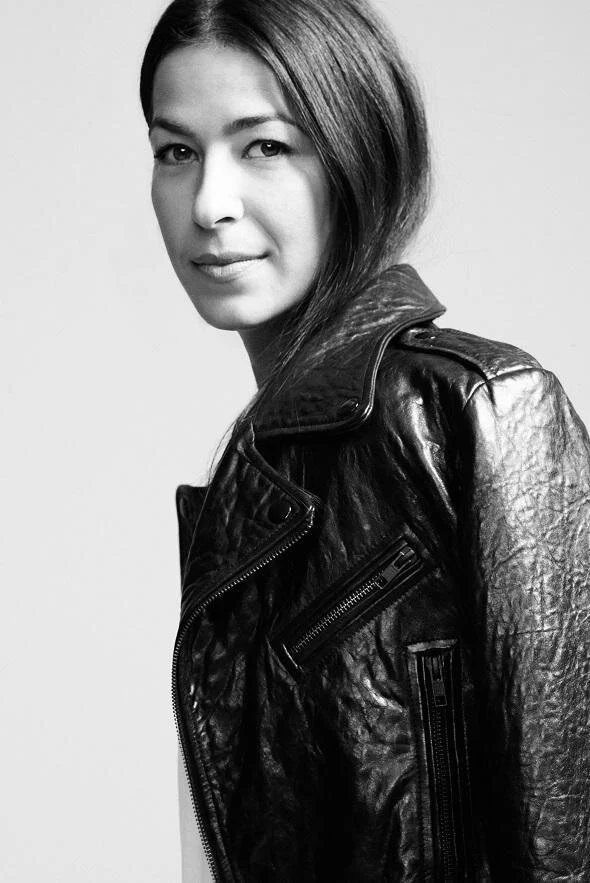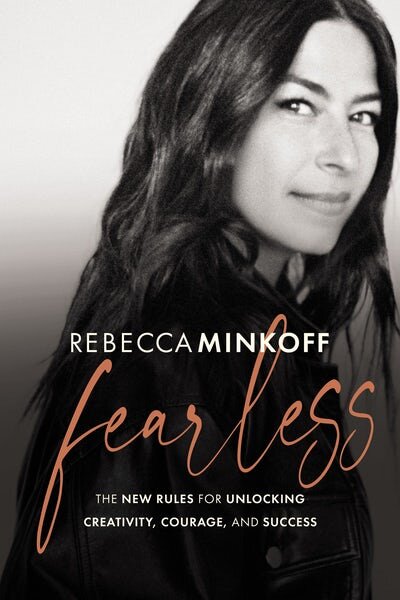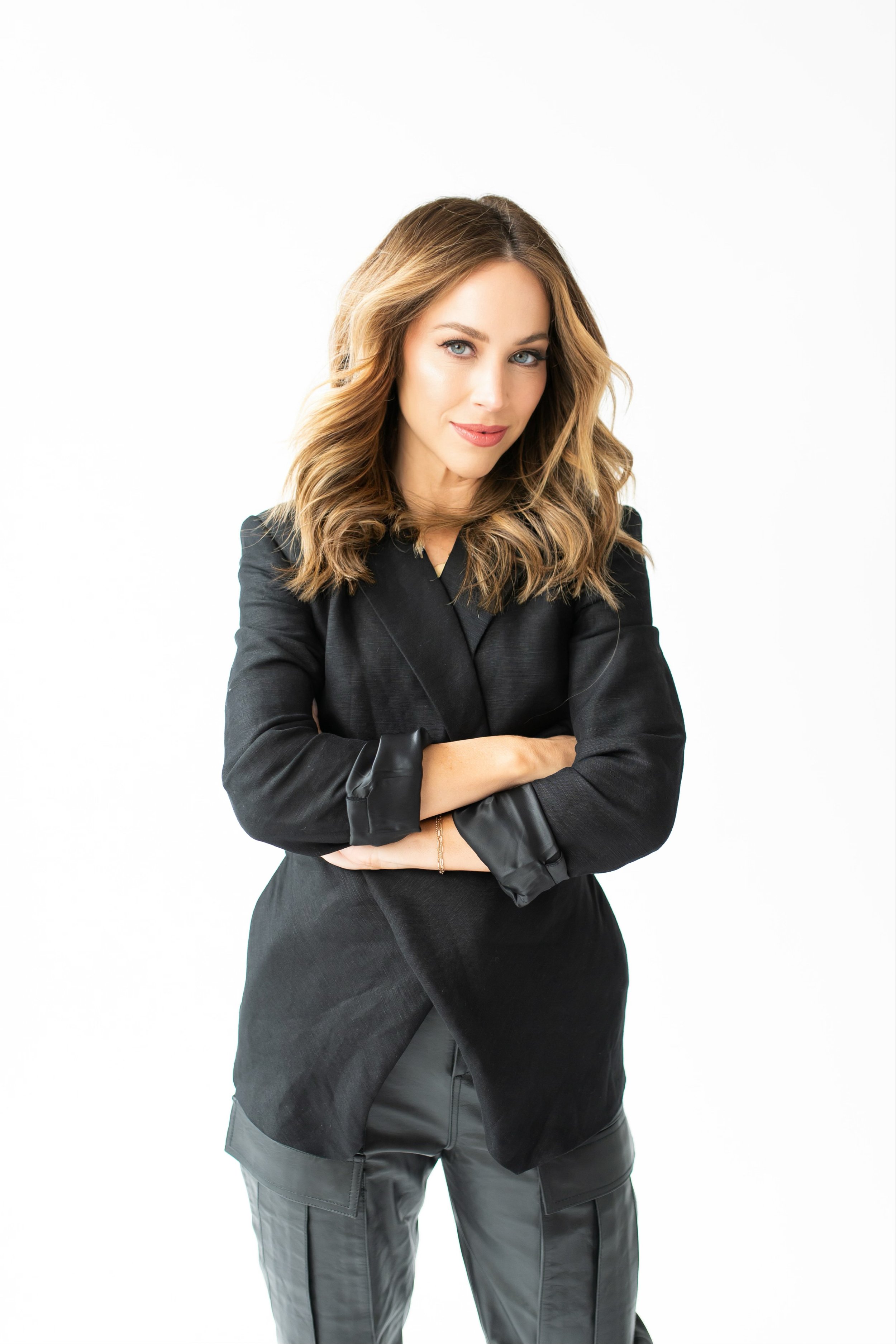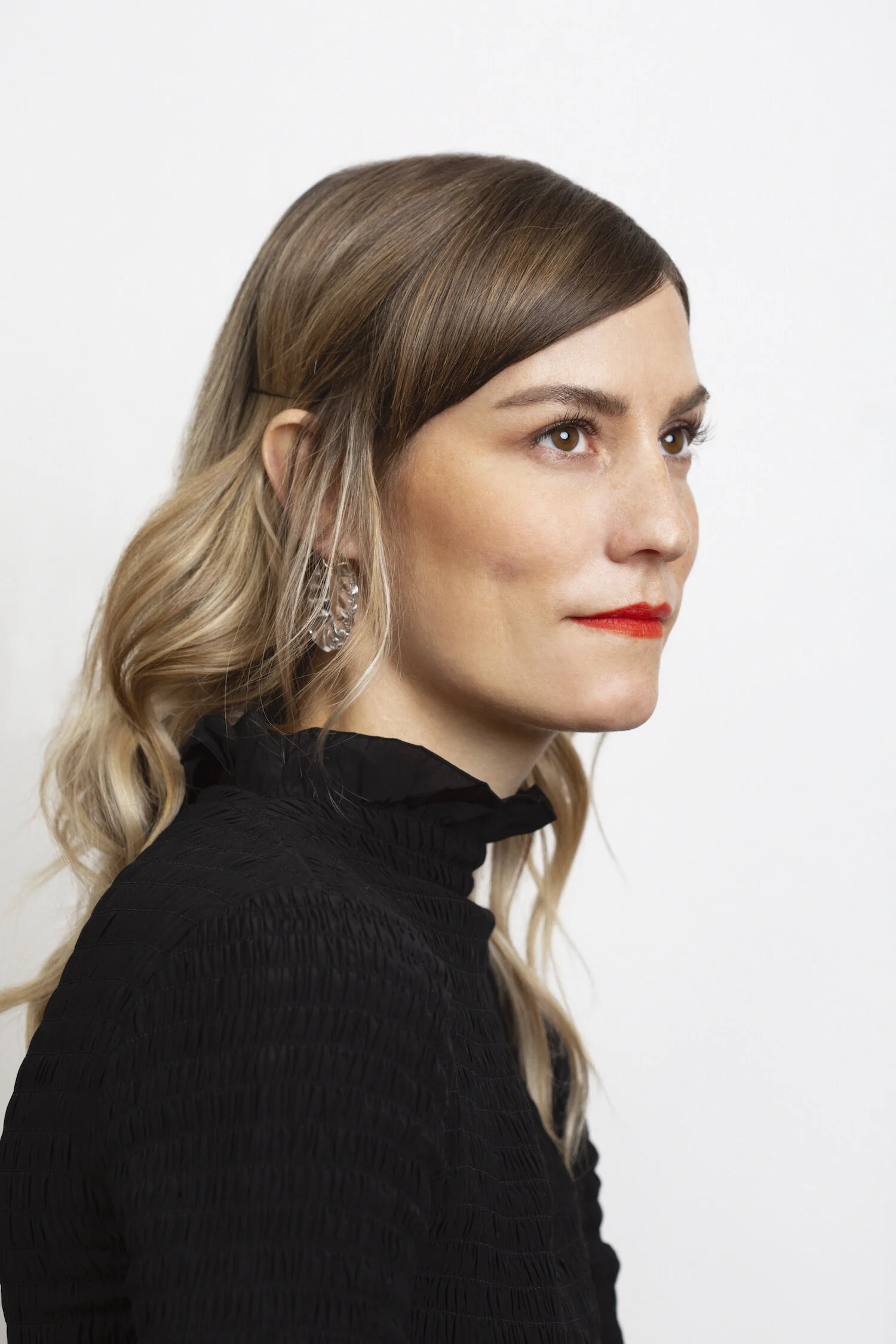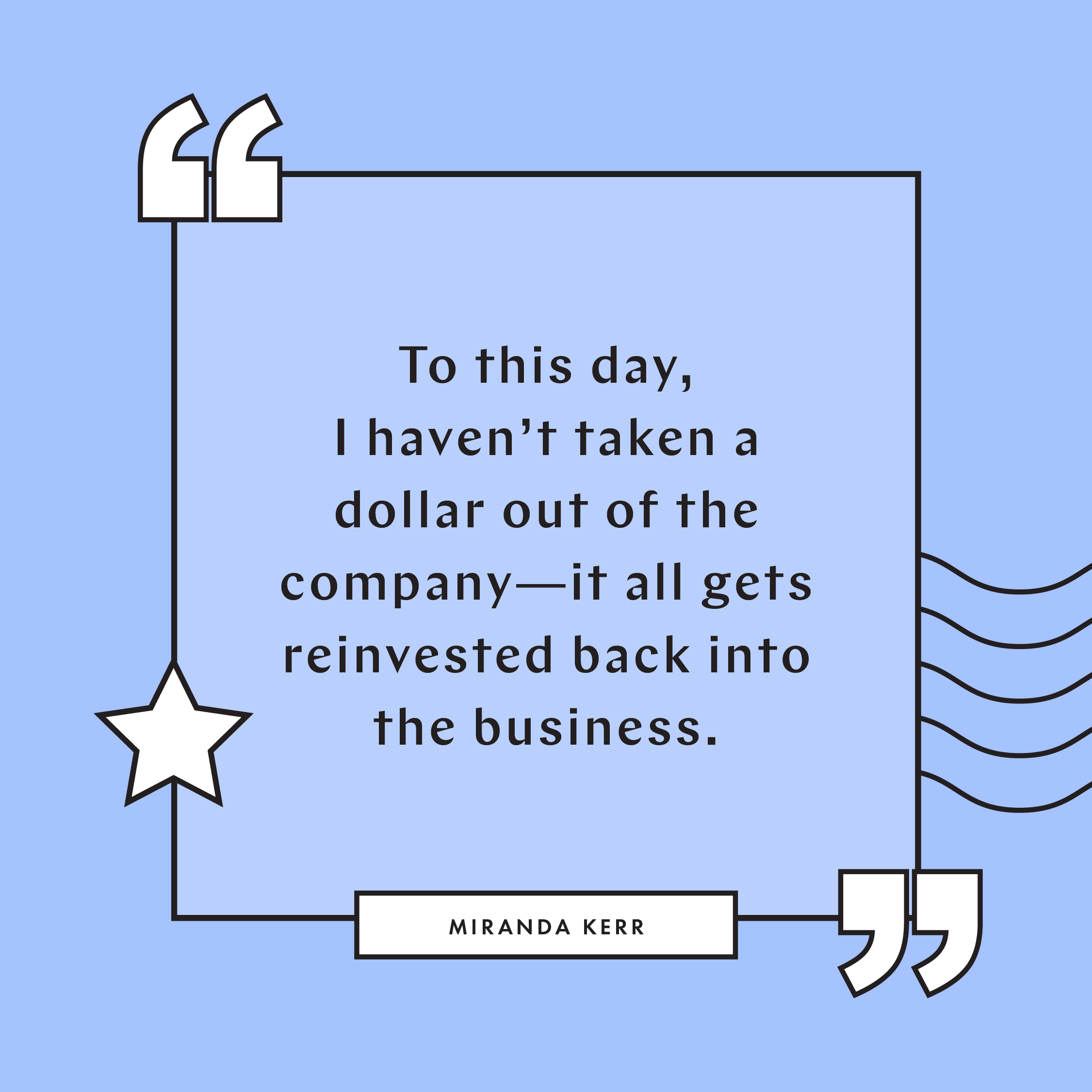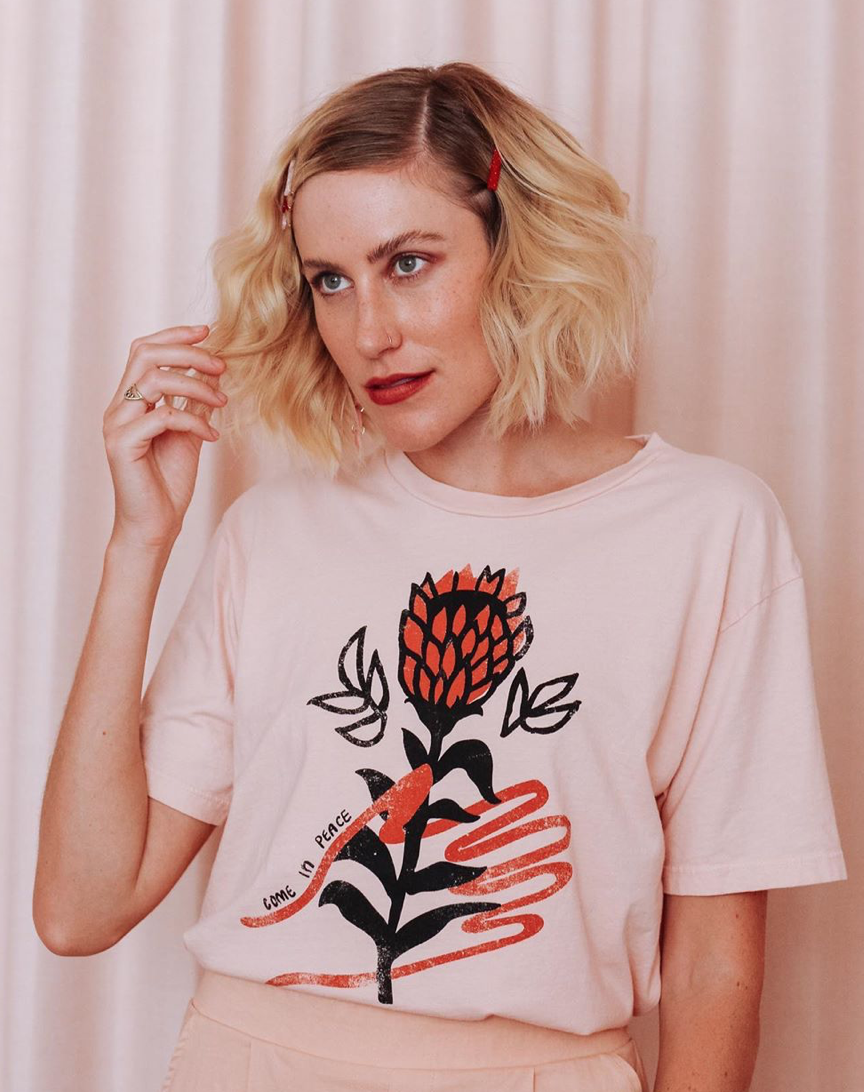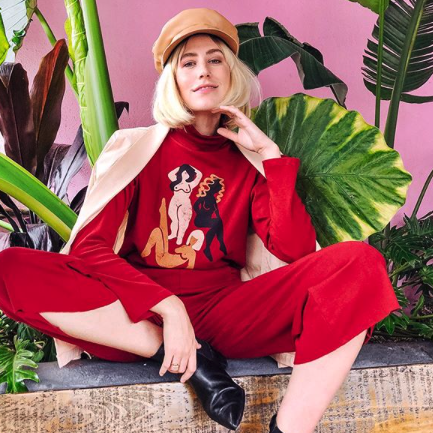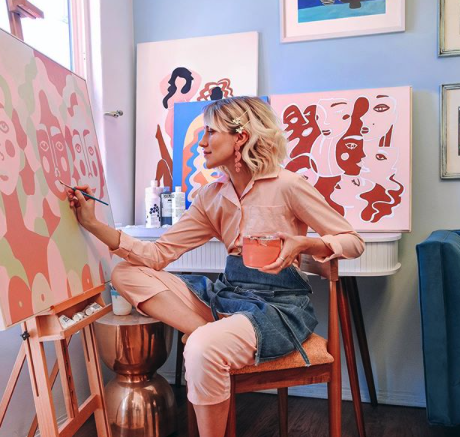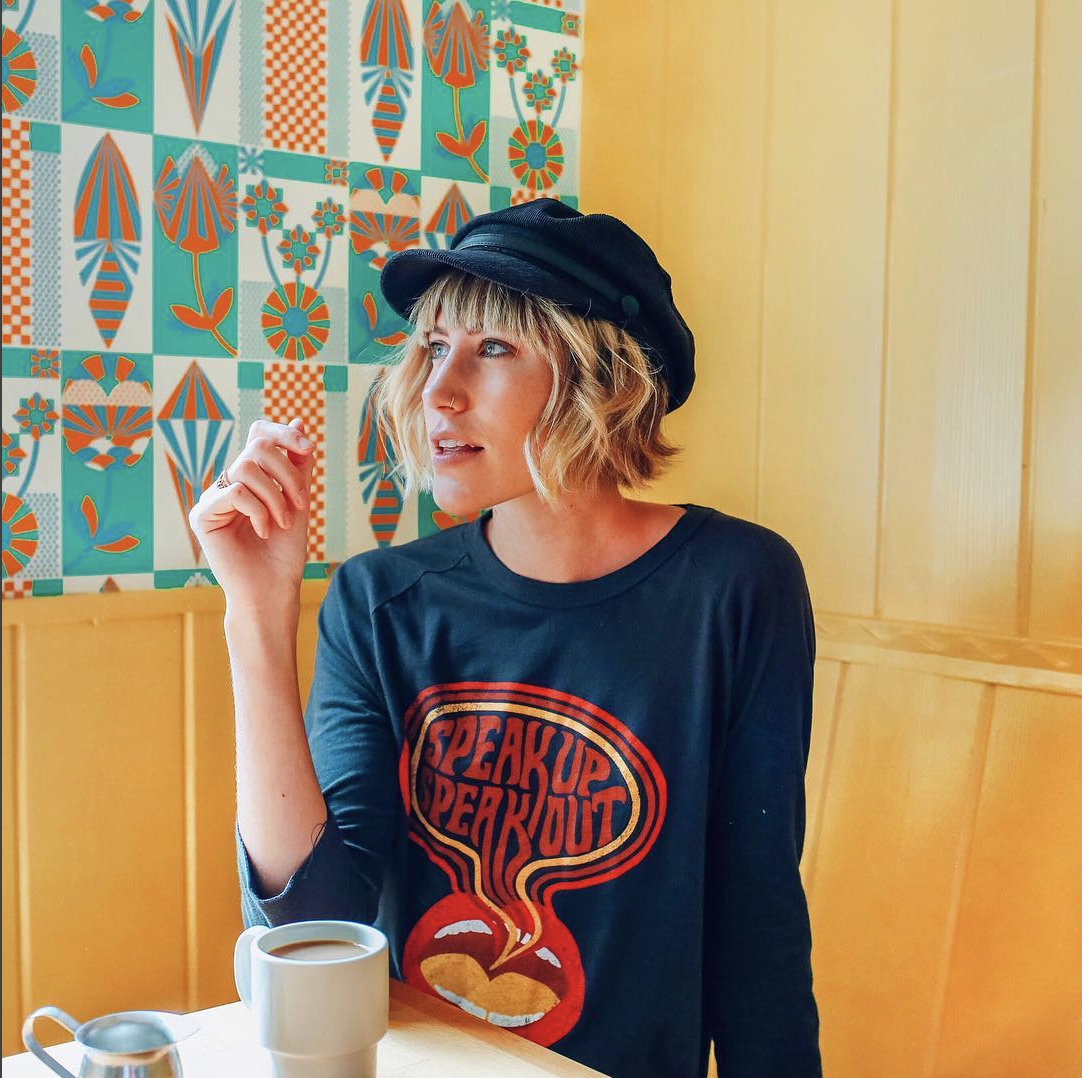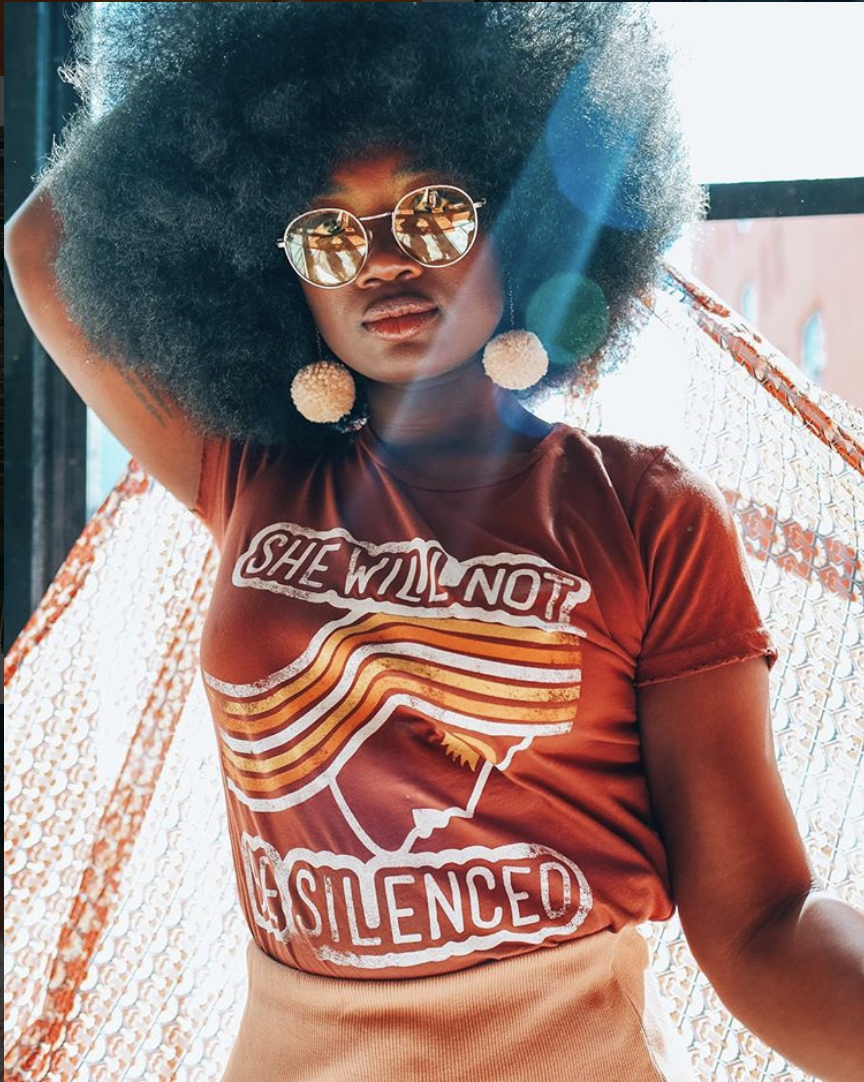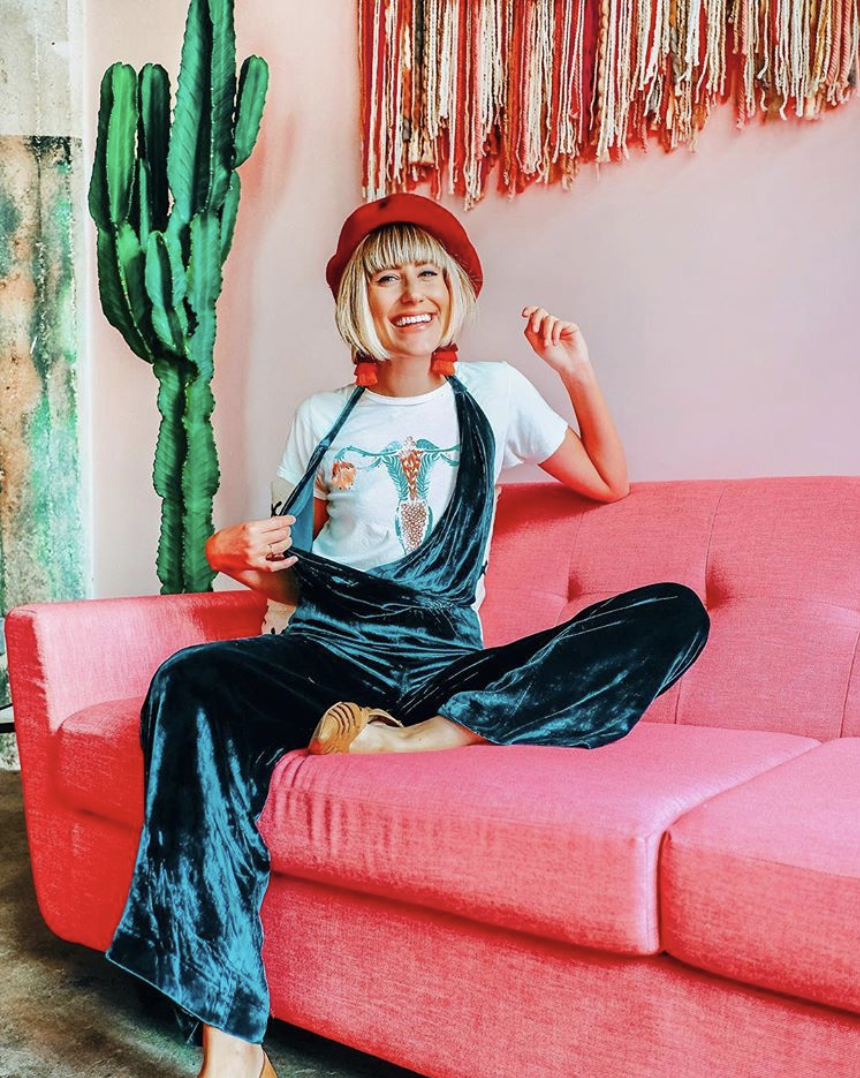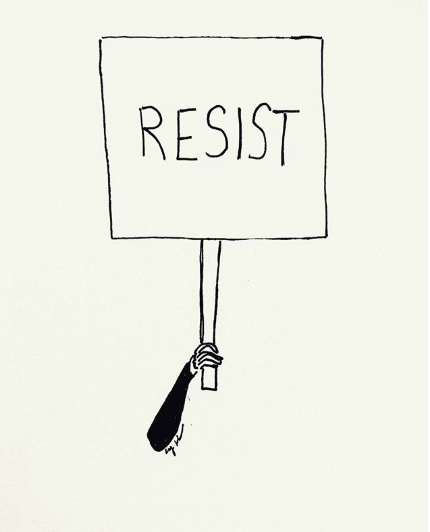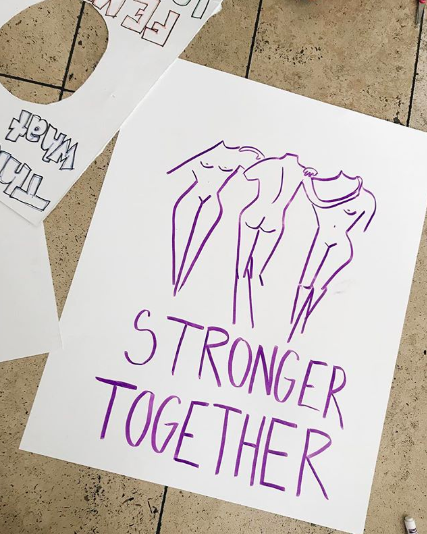Rebecca Minkoff Doesn’t Believe in Asking for Permission—and Neither Should You
An excerpt from the designer's new book, "Fearless."
“Really, the only person you need permission from is yourself. Not your parents. Not your friends. Not society.”
—Rebeca Minkoff, Co-Founder and Creative Director of Rebecca Minkoff
At Create & Cultivate’s Money Moves Summit, Rebecca Minkoff opened up about her slow-burn success, working hard and never giving up, and leading a company through tough times. In her new book, “Fearless: The New Rules for Unlocking Creativity, Courage, and Success,” she shares even more learnings from her decades-long career. Below is an excerpt from her new book in which she shares one of the most valuable career (and life) lessons she’s learned so far:
The first dress I ever designed for myself was for my bat mitzvah. A few years before, I had seen a polka-dot dress in a store window and became obsessed. It was just a simple A-line shift dress, but to me it was the coolest dress I had ever seen in my life. Even though I couldn’t touch it, in my mind, I knew it was made with the softest cotton I’d ever felt. The sleeves had just enough pouf to be stylish without feeling kooky or too kiddie. I knew it would land right above my knee if I ever had a chance to try it on. Like most kids, I begged my mom to buy it for me. And, unlike most moms, my mother said, “I’m not going to buy this for you, but I’ll buy you fabric and you can make it.” That was a real light bulb moment for me. I had been crafting and making cutesy, fun things like aprons and pot holders, and I’d been using puffy paint and sewing patches on my jean jackets, but this felt like a revelation. If I designed something fashionable, did that make me a fashion designer? That sounded really cool.
Asking my mom for things and having her turn me down was pretty much par for the course. But the truth is, she just wanted to teach me how to figure things out for myself. She didn’t buy me that dress, but she guided me as we made one—and I thought it was even cooler than the one I had seen. Now, I was twelve, and between the idea of becoming a “woman” for my bat mitzvah and having a size AA training “bra” (think: stretchy cropped undershirt), I very much felt like I needed a dress that would highlight and showcase my chest. (Why, you ask, was my focus on my chest instead of on my Torah portion? Tweens aren’t exactly known for their impeccable priorities.) This became my first design challenge. I decided on an empire waist with a square neck and a little princess puff sleeve, and I made it out of white matte silk. I made it just above my knees so that you could see my gams when I sat on the bima (that’s Hebrew for the stage). My mom wouldn’t buy me new shoes for just one night, so a family friend lent me her cream-colored pumps that matched the color of my dress exactly. I wore them with pride even though they were a half size too small. (But I did spend most of the time up on the bima worried that I was losing circulation in my feet.)
Thanks to my mom shutting me down, I got way more out of the experience than just an amazing (go with me here) dress. Sewing something that I could wear gave me confidence. The idea of turning nothing but a piece of fabric and some thread into something I would actually wear out in the world seemed like magic to me. I would do as many chores around the house as I possibly could in order to earn money and then spend it all on fabric. When I was out of fabric and out of cash, I would go through my closet and find pieces that I was tired of, take them apart, and make something new to wear. Taking the clothes apart allowed me to see how the clothes were made, and then I could replicate the look if I wanted to.
When Life Throws You Lemons—or Florida Oranges
I was born in San Diego in the eighties. It was absolutely as fun as it sounds. My early life in California was a truly idyllic time period. The weather was always perfect, my two older brothers and I could go outside and play at night unsupervised, and I spent weekends boogie-boarding or selling jewelry at the flea market while my mom sold her Amway products. My dad had just finished his residency in pediatric medicine and had opened his own practice. He worked a lot, but when he was home, he was all ours. We were not wealthy by any means, but my life felt rich. My elementary school self already knew that I was going to marry Steve and that Sarah, Caren, Rachel, and Tami would be my bridesmaids. I was going to wear a ruffled one-shouldered white organza minidress, and my bridesmaids would each wear their own unique look that reflected their personality, but it had to be coral pink, obviously, because the wedding would be on the beach. Cue the mic drop.
Shortly after I turned eight, my parents told us we would be moving to Florida, where my dad would be taking a short sabbatical. All I knew about Florida was that there were alligators in the swimming pools. I remember coming home and my parents breaking the news to my two older brothers, Uri and Max, and me. They presented it like it was an adventure, and I was completely not on board. As I sat there panicking about losing my friends, my dad sold us on the move with big talk of a house on the ocean, building sandcastles in the front yard, and promises that he would have tons of time off to play with us. So we packed up. Everything I owned, which primarily consisted of Barbies, Barbie clothes, Barbie gear, and a Barbie Dream House, was in boxes and ready to be loaded onto the moving truck. On my last day of third grade, my classmates gave me a memory book full of photos and drawings from my elementary school friends. I’d never held anything as tightly or cried as hard as I did that day.
The Big Adventure
We piled into our sedan, hitched up the U-Haul, and drove across the country in true Griswold-family fashion. It was the absolute worst. The whole time, I had to sit in the middle seat, squished between Uri and Max, because I could never yell out “Not it!” fast enough. At any given point during our drive, I was either being used as a pillow or an armrest. There were a lot of tears: like when my personal stash of mini candies fell out of the trunk into the muddy parking lot, or when we pulled into New Orleans and I felt completely haunted while semi-lost from my family, or when my dad fell asleep at the wheel in the middle of the night and we did not one but two 360s across the freeway. It was the longest, crummiest week of my eight-year-old life. But at least we were moving somewhere awesome, right? Wrong.
The night that we arrived in Florida, we were tired, it was hot, and I was sure that when my dad pulled into the dilapidated, half-rotted apartment complex, he had made a wrong turn. It was just like The Karate Kid, but I wasn’t Danny LaRusso and there was no Mr. Miyagi waiting to give me a shiny yellow convertible. I remember piping up to say, “Dad, you made a wrong turn. We are not at the beach.” He replied, “Oh no, honey. This is correct. We decided this would be much better.” We went upstairs to a two-bedroom, one-bathroom apartment that was roughly the size of our living room back in San Diego. The place smelled. Mold was everywhere. My heart sank. Even our two dogs seemed grossed out. This was not part of my plan. I woke up the next morning before everyone else. I threw on my Chucks and ran out the door, determined to find the mythical sand and magical beach that Dad had promised. I knew it was all wrong the moment I stepped outside and didn’t feel the tangy taste of saltwater surrounding me. Lo and behold, all I saw was dirt. It could have passed as sand-colored dirt, but it was definitely dirt. That’s what was at the bottom of the stairs. That’s what I was supposed to turn into castles? And where was the water? How was I going to fill the moats of my princess castle without the ocean nearby? I had promised Barbie a beach day, and she was going to be pissed. Even more than me.
I quickly ran back up the steps, found my father, and demanded, “Dad! Where is the beach? And the sand?” His reply: “That’s sand! Right at the bottom of the stairs!” The first few months went like this for everything we did. When I looked for the Floridian version of the fun downtown we had grown up with back in San Diego, where kids could innocently loiter, he told me it was out there somewhere and we would find it. When I looked for the group of really nice, super-friendly girls my age who were destined to be my new best friends, he told me I was sure to meet them soon. When I wanted to boogie-board, there wasn’t even a wave. And what I did find wasn’t helping the situation: I missed the soft green grass of California, but all I had to look at was dry, hard, spiky patches of Florida turf. I had always liked being connected to our Jewish community back home, but the jerky tweens at the temple in our new town made fun of me for my buck teeth and frizzy hair. I was constantly disappointed, and I missed my old life deeply.
The only saving grace was that it was temporary. At least that’s what I thought. Since the plans were up in the air, my parents rented furniture instead of buying it or moving our old stuff out from California. I marked the day our first furniture rental contract was up on the family calendar. When the big day finally arrived, I ran to tell my dad: “Hey, Dad! We have to return the furniture! Does that mean we can go home now?” He turned to me and very casually said, “We’re not going home. We’re going to stay.” My parents had found a small piece of land that was going for a good price and had decided to save up to build a house of our own. I knew at that moment that my fate was sealed. I was stuck there for good. (And, Florida, if you’re reading this, please don’t take offense. I’ve grown to love you, and you know it.)
Even now it stings. I say this fully aware, as an adult human, that I was very lucky to have a roof over my head, to have a loving family, and to always have food to eat, but San Diego was all I knew. When everything you have ever known as a child is ripped from your life, it has a huge impact, whatever your circumstances may be. This was like a bad after-school special, but it was my real life—though it wasn’t the last disappointment I would face, so technically it was training.
So why was Florida so bad? Let’s unpack this:
It was hot—the kind of hot where you just are never not sweating. All the time. I couldn’t even walk from my mother’s car to the front of the school without my sweat staining my shirt.
I had very few friends. I thought I had made some, but Chrissy turned out to be a traitor in junior high when she up and decided I was too nerdy and awkward to be seen with in public. I wound up getting bullied left and right and dreaded every morning that I had to get up and go to school.
My older brothers turned into teenagers and left me behind. While they were suddenly doing all the normal, eighties-movie high school stuff, I was stuck at home, playing with my dolls, and waiting for my hot-glue gun to warm up.
On top of everything, we were the only Jewish people for miles and miles, which made us the talk of the town.
All of this is to say that I found myself flying solo. A lot. Depending on my mood, it either felt as if I had all the me-time in the world or as if I had been forced into isolation. The upside of it all is that it gave me the space to discover creativity. Crafting saved my life. (Does that sound dramatic? I hope so. I really want it to.) I was a mini Martha Stewart always ready with my Mod Podge and handful of puffy pom-poms. My mom had given me an old sewing kit and showed me the basics. It wasn’t long before I was making scrunchies for myself and avant-garde outfits for my dolls.
Out of everyone at school, my favorite person was Miss Laurie, the art teacher. She had moved to Florida from New York City, where she had been a print designer. Now she handed out construction paper and was on scissor patrol for a bunch of kids. Miss Laurie was kind and soft-spoken, and she used validation and encouragement to keep you going. She could always find something in whatever mess we kids were working on to compliment. After school, she taught art classes out of her home. For twenty dollars an hour (her rate was actually thirty dollars an hour, but my mom insisted that I negotiate her price down), she would teach me whatever I wanted to learn. Over five years, we drew, painted, illustrated, sketched, knit, and crocheted, and, most importantly, she taught me to follow a pattern and use a sewing machine. Thanks to her (and the extreme nothingness of Florida at the time), I found my love of fashion, art, and design.
Don’t Ask; Do
From then on, I was hooked on doing things for myself. When I decided I wanted to go to the performing arts high school that was forty minutes away, I mapped out the bus route and got myself there and back. How much I earned doing chores around the house or scooping ice cream at the local ice cream shop, where I worked after school and on weekends, was how much I could spend. The responsibility was on me. At a certain point, making things, doing things, and figuring things out on my own became second nature to me.
With my love for all things fashion, it wasn’t a surprise that, when I was eighteen, I decided I wanted to move to New York to work in fashion. My mom said, “If you want to go, go.” That was all I needed. She wasn’t giving me permission. She wasn’t saying yes or no. She was putting the responsibility exactly where it belonged: on me. A few years ago, I finally asked my mom why she didn’t help us kids out more. She explained that when she turned eighteen and moved out of her parents’ house, she didn’t know how to do anything. She felt like too much had been done for her, so she had trouble knowing how to live on her own. As a parent, I’ve learned that is the greatest gift we can give our kids—just a push in the right direction. (Thanks, Mom. Love ya.)
I didn’t have a plan. I wasn’t sure how I was going to make it happen. But I knew I was going to figure it out.
Sign Your Own Permission Slip
We spend so much of our lives waiting for permission. As little kids, we ask our parents if we can do just about everything. We ask for snacks, for toys, or if it’s okay to go out and play. We even ask our teachers if it’s okay to go to the bathroom. By the time we’re adults, we’ve been conditioned to look outside ourselves for someone to give us permission to do even the little things.
But do we really have to? No.
Really, the only person you need permission from is yourself. Not your parents. Not your friends. Not society. When we ask someone else to validate our choice before we make it, it puts the responsibility on that person. Suddenly, it’s their problem if something goes wrong. Getting outside validation protects us from feeling like it’s all on us if we screw up. And on some level, we’re all afraid of screwing up.
But here’s the thing: if we get permission to do something, or validation before we do something, we aren’t off the hook. We still have to deal with the fallout. We’re still the face of the mistake. Often, the only person who actually cares, or even knows, that someone gave you permission is yourself, so if you want to do something, do it. If you want to wear something, wear it. If you want to try something new, by all means, go for it. Whatever happens next is yours to own. It’s all you.
“Fearless: The New Rules for Unlocking Creativity, Courage, and Success” by Rebecca Minkoff
$26
Taken from Fearless by Rebecca Minkoff. Copyright © 2021 by Rebecca Minkoff. Used by permission of HarperCollins Leadership. www.harpercollinsleadership.com.
MORE ON THE BLOG
What the International Black Lives Matter Movement Meant for My Business in 2020
One founder opens up about overcoming imposter syndrome, sustaining rapid growth, and reflecting on the diversity of her own professional network.
Photo: Courtesy of Andréa Jones
Last year was a challenging year of growth for both me and my business. Although I was by no means new to the entrepreneurial world, the events of 2020 would take my business to new heights because of the Black Lives Matter Movement.
Heading into 2020 I was excited to renew focus on my coaching and course offerings. I was feeling good about my revenue and I wanted to pour my efforts into producing more automated programs. But in March, when the pandemic really started to get attention in the U.S. and Canada, my team and I realized that we needed to pivot and service offerings were the fastest way to revenue growth at the time.
Over those first few months of 2020, like many others, we did lose some clients, particularly our clients in the event space who essentially lost their businesses during the pandemic. We also had a few clients who decided to take social media in-house as a way to cut costs. We experienced a lot of major changes within our business as I'm sure other business owners did as well.
But even though it was a challenging time, my team rose to the occasion and quickly turned things around. Within a month we had compensated for the abrupt slowdown and reached the March goals that we had previously been behind on. I’m incredibly proud to say my team really weathered the COVID-19 storm with tremendous grace and success. We headed into May feeling really great about our perseverance and growth as a company.
This would later become crucial to helping me stand with confidence about how my company serves its clients and brings value. Because once again, 2020 threw us another curveball and we found ourselves in the midst of worldwide demonstrations for Black lives following the death of George Floyd. Suddenly my company was put front and center because it was Black-owned and I really wrestled with if that was a positive thing or not.
When the Black Lives Matter movement started to pick up widespread media attention, a lot of businesses in the online space began tagging Black entrepreneurs or business owners they worked with as an effort to uplift Black voices. From there, many business owners began examining their network of contractors, or the agencies they hired from a diversity standpoint, realizing they should make a more conscious effort to diversify the people they work with. That’s when I really started to notice a shift in my own business leads. I checked almost all of the marks for someone looking for a diverse team. I am a Black woman, I have team members who are part of the LGBTQIA+ community, and I have team members based all over the world as an internationally based agency. A lot of companies found this quality of our company attractive and hired us.
When the light was shone on me as a Black business owner, I felt very uncomfortable at first and dealt with a lot of imposter syndrome, especially since I do not consider myself to be a Black rights activist. An avid follower and supporter, yes. But an activist? Hardly. The Black Lives Matter movement also put a lot of emphasis on me as a Black woman, but before last year, I had honestly not thought of myself as a Black woman business owner, simply a business owner.
I never foresaw the color of my skin being the reason people noticed me and wanted to work with me. It felt like a lot of the reason people were deciding to hire me and my company was only because I was Black. There was a lot of work that I had to do around that to shift my mindset.
What helped me work through this imposter syndrome I was feeling were two things, really. The first was reminding myself that these prospective clients may have been seeking me out because I was Black, but they certainly weren’t hiring me or retaining my services because I was Black.
My team does incredible work, as we had proved several times, including during the pandemic. We were able to sustain the rapid growth we were experiencing because we had designed a great service that was set up on the back end and we were getting results for our clients. So, whenever I had feelings of doubt, I reflected on how awesome my team was, and then I reminded myself that I had built that team.
The second thing that really helped me through this imposter syndrome I was wrestling with was something my dad told me. (What’s really funny is his wisdom actually came in the form of a sports metaphor and I am the least sporty person out there.) I told him about the unease I was feeling over all the attention I was receiving and asked him how he was dealing with the Black Lives Matter movement as a Black business owner himself. I absolutely loved his response, which was: “Think of it as your ‘at bat.’” He went on to say, I should think of this time as my turn at the plate. Just because I step up to the plate does not always mean I am going to hit a home run. It doesn’t even mean I’ll necessarily hit the ball. But I do get my chance at the plate, so why not take it? It was that mindset shift that helped me be okay with the attention I was getting and lean into it.
By learning to embrace the attention I was receiving because of the Black Lives Matter movement, I overcame the imposter syndrome and my business was able to grow both monetary and team-wise. In fact, over the course of 2020, my business tripled in revenue and we added over six new members to our team. Because of that growth, we’re able to reach and help more people. We’re able to show up in a different way, offer more services, and expand our reach.
And the movement didn’t just impact my clientele, but also my personal professional circle. A surprising realization I had was that my own professional circle was not diverse enough. It’s no secret that the digital marketing industry is chock-full of white men, but I fell right into the trap of just going along with what was right in front of me versus making a conscious effort to create change. After critically looking at the group of people I had connected with initially, I started spending concerted time and effort diversifying my network.
One of the resources I went to is the We Should All Be Millionaires Club by Rachel Rodgers. Her fantastic and diverse group of business owners helped me realize just how much I needed to be around people who were going through the same things that I was. They were business owners like me who were also getting a giant spotlight shone onto their businesses because they were Black and we got to share how everyone was dealing with it.
Some were celebrating finally being able to show up and be seen and seeing these business owners’ positive energy around the attention they were receiving helped me really accept the spotlight on my business as well.
I remember how personally invested I became in the movement, and as I reflect on this, I think one of the reasons is because the Black Lives Matter movement really shone a light on the things I had been doing and striving for already in my business. Essentially, the rest of the world was catching up to where I had always been, and I was finally reaping the rewards from that work. Instead of hiding from it, they encouraged me to embrace it.
This whole year taught me lessons that I will carry with me as an individual and as a CEO and business owner for the rest of my life. It’s reinforced the importance of diversity and allowed me to embrace my experience as a Black business owner. I vow to always employ a diverse staff and foster a diverse social and professional group of people around me to influence and guide my thinking and decisions.
If I can leave you with my biggest lesson from the Black Lives Matter movement it is this: everyone should examine their professional and social circles and make a concerted effort to diversify those circles. The experiences and lessons we gather from having a diverse circle can do amazing things, and I think we can all use that as a guiding compass as we continue into this new year.
About the Author: Andréa Jones is fiercely committed to helping businesses and podcasters build profitable online communities through simple social media solutions. She's the host of the Savvy Social Podcast, which was nominated for “Best Business Series” at the 2020 Canadian Podcast Awards.
Andréa is also the creator of the Savvy Social School, a digital platform designed to teach its 100+ members (predominantly small business owners) how to implement organic social media strategies. For those businesses seeking a curated, done-for-you approach to growing an engaged online audience, Andréa and her team of seven serve nearly two dozen notable brands across the globe.
Named one of Social Report's top marketers to follow, Andréa can routinely be found speaking at highly-publicized events, including Alt Summit, Podcast Movement, and PodFest. You can find her online at onlinedrea.com or @onlinedrea on Instagram.
MORE ON THE BLOG
8 Ways to Grow Your Personal Brand, According to an Influencer With 1M Instagram Followers
Marianna Hewitt spills the tea.
Have you always wanted to know what it’s like to be an influencer and grow a business out of your influence? We know you’re all craving insight on how to grow a brand and ramp up your social media presence right now so when we came across influencer and co-founder of Summer Fridays, Marianna Hewitt dishing her career advice and social media tips on Instagram stories, we had to screenshot it all and share it with you here.
Hewitt asked her Instagram audience—she has 1 M(!!!), followers—to send in their questions on all things business, social, and #influencerlife. Whether you’re an aspiring influencer, a brand trying to grow, or need some major inspiration, Hewitt’s insight is golden. She pulls back the curtain to share all the realness.
You asked, she answered. Scroll on for major tips, then don’t forget to grab your tickets to the Money Moves Digital Summit to see Hewitt speak on all things, money, career, business, and more!
How do you come up with fresh content so that your followers don’t get bored?
I just ask! Whenever I need new ideas I ask what the followers want to see. I have a document saved with all the answers and then I note what gets the most requests and do those.
Being a beginner, how do you grab a brands’ attention?
I think picking a niche at the beginning helps soooo much. You become the go-to expert on that subject! Creating beautiful content helps to get reposted or for brands to notice you. I
f you want to work with a brand, buy their products and use them and share them organically to show the brands what kind of content you would create for them and how your audience responded to you sharing it.
Also, not every brand has a budget to work with influencers and if they do it could only be at certain times for particular campaigns or launches that they would have budgets. So keep it in mind that brands don’t just freely have money all the time. But by posting and sharing them organically, hopefully, they will help keep you top of mind when opportunities do come up.
How did you grow your following?
“I just did a podcast interview and talked about this, you can find that here.”
Do you think it’s too late to become an influencer because it’s so saturated?
“Not at all! But that’s why having a niche is important when first starting so that you can build a micro-community who comes to you as an expert on one thing. I don’t think you need to be niche forever, but when you start, I think it helps so much.”
How do you build relationships with other influencers?
“Follow them. Like and comment on their posts.”
Can you grow your Instagram without using a lot of hashtags? How did you grow yours?
“I don’t really know if hashtags are that relevant. I don’t think you need them to grow your page. I think you’re better off tagging brands and getting reshared. And following people in your niche and engaging with their content and hope they follow back and do the same.”
What are some things you wish you knew before starting your influencer journey?
“It’s a lot of work. Most of the work you do is for free and you don’t get paid. Because you’re creating organic content every single day that isn’t sponsored. Let’s say 10% of your content is sponsored. Then 90% of your work you do for free. So you have to be okay with doing a lot of work to hopefully get paid opportunities. You can also make money through affiliate links.
When you are an influencer you are:
The model
Photographer
Videographer (if you do IGTV or YouTube)
Editor (for video)
Social media manager
Community manager
Writer (captions or if you have a blog)
Stylist (if you post fashion content)
Makeup artist (if you post makeup content)
And so many more things! Being an influencer is so many jobs rolled into one.
How do you keep your feed cohesive without a filter?
Take photos with similar colors. So you’ll notice there’s no black in my photos right now. So if I took a picture on a black wall or with a dark outfit, it wouldn’t match. So just take pics of things that go together.
Does the grid matter?
I do think your feed matters to new followers. When a new person comes to your page they see the first nine to 12 photos so it should get their attention and make them want to follow and have an idea of what kind of content they’ll be getting from you. I don’t think feed matters as much to existing followers because they likely just see the new posts but not as frequently go to your profile.
How do you find your niche?
Your niche should be your “thing” so it should be easy to narrow down based on what you are passionate about or an expert in. I like to think of content pillars and posting mostly those topics; so a few things that you like. You can post a few things and see what’s resonating most with your followers and getting the most engagement. Then post more of that.
How do you establish your first partnership if you’re just starting out and don’t have high follower numbers?
I would ask yourself:
Why would this brand work with me?
What am I bringing to the table?
And pitch them your strengths:
Did you post them before and convert a lot of sales?
Do you have data to show that?
Do you create beautiful content, and can you work with them to create assets for their socials?
How do you decide which platform to post your content? Instagram, YouTube, TikTok, or blog?
Instagram:
Photos
Stories/daily posts in the moment and more quick content
YouTube:
Longer videos
Content I want to live longer or videos that are searched for
Blog:
More writing than what would fit in an IG caption
Lots of shopping links and roundups of items
How do you keep motivated to post stories every day?
I genuinely love to create content and share. So I never feel like I “have” to do it. I *want* to do it. On the days I don’t want to, I just don’t. Like for my feed right now I don’t have a pic to post next and haven’t felt like getting ready so I just didn’t post on my feed yesterday or today.
How long did it take for you to get a substantial follower base?
I started Instagram very early on in 2013 when it was much easier to gain followers than it is now. I gained a large audience by 2014 but then continued to grow it. I was at 500k in 2016 (it took me from 2013 to 2016) and hit 1M in 2020. So it took me four years to reach my second 500k.”
What is the biggest struggle with being an influencer?
“There is zero job security and you have no benefits. At any time (like now) brands could all cut their budget for sponsored content and what would your job be? How will you make an income? There are no sick days. There are no days off. There is no maternity leave. All the pressure is on you.
Since you are the influencer and face of the “brand” you cannot delegate things to other people. You are the one in the photos, in the stories, etc. There are a lot of benefits though and it’s an amazing opportunity to do this full time but there are so many risks so you just have to be okay with that!”
For fashion content: Do you think a blog is necessary or can someone be successful only using Instagram?
“If you want to be a blogger then yes you need to have a blog. But if you want to be a social media influencer or content creator, no you do not need a blog. Think of some of your fave influencers, they probably don’t have a site!
Do you use a professional photographer for full body shots?
No, I’ve been shooting all my content at home on my iPhone. I generally only shoot with a photographer for sponsored content because I want the highest quality photos for the brands.
How do you pay your agency for managing you? Do they take a percentage on your earnings?
Yes, they make a percentage of the deals they bring in for me. Then the percent I get for myself, I pay taxes on (because we don’t get paychecks so our taxes are taken from the money we bring in) and then pay out employees, creatives, etc.
Like what you see? Catch Marianna Hewitt at the Money Moves Summit, May 2nd, live from your couch!
Ask an Expert: How to Adjust Your Business Strategy During the Coronavirus Crisis, According to a Business Coach
“This is a time to be swift, but not reactive.”
We’ve been spending a lot of time at Create & Cultivate HQ discussing how we can best show up for and support our community during this uncertain time. Community is at our core, and connecting with others through one-of-a-kind experiences is what we love to do. While the world has changed, our mission has not. We’re committed to helping women create and cultivate the career of their dreams, which is why we’re proud to announce our new Ask an Expert series. We’re hosting discussions with experts, mentors, and influencers daily at 9 am, 12 pm, and 3 pm PST on Instagram Live to cure your craving for community and bring you the expert advice you’ve come to know and love from C&C. Follow Create & Cultivate on Instagram, check out our Ask an Expert highlight reel for the latest schedule, and hit the countdown to get a reminder so you don’t miss out!
Photo: Courtesy of Gretchen Jones
In times of crisis, businesses are put to the test—supply chains are disrupted and profit margins are compromised. And the COVID-19 crisis is certainly no exception. As our founder and CEO Jaclyn Johnson says, a company’s success comes down to how it pivots and responds during times of great uncertainty. However, as one of today’s Ask an Expert pros reminded us, “Now is the time to be swift, not reactive."
For some #realtalk on how to pivot a business, manage expectations, and lead with purpose during a crisis, we tapped Gretchen Jones, a strategic business advisor (she advises our CEO), for a special installment of our wildly popular Instagram Live series, Ask an Expert. Read on for three things you should know about adjusting your business strategy right now. If you missed the conversation, you can watch it in full here, and be sure to tune into our next Ask an Expert conversation on Instagram Live.
1. I want to be proactive during this time of quarantine—what can I do to reach my business growth goals and hit the ground running when things go back to normal?
“Achieving business goals right now is theoretical. More than thinking about growth, work on managing a healthy relationship with your business, not the potential capabilities ahead of you. Look at this slowdown as an opportunity to rise to the occasion, and look at initiatives that you’ve wanted to dive into but haven’t had the time to until now.“
2. I’m a small business owner and I don’t know how much longer I can afford to pay our staff while we’re closed during this time of quarantine. What advice can you share?
“Being a good boss sometimes means that moving through the pain [and going through with layoffs] is doing what is right for your community because you acted with integrity. You holding onto your staff because you’re afraid of laying them off in the future is going to complicate they’re ability to gain access to unemployment benefits. Take care of them now so that they will want to come back and work for you.”
3. How can I be a better, more supportive leader for my team, especially now that we’re all working remotely?
“The first thing is communication. Lead with humanity first in all communication. And, set goals. Real goal setting is about making sure your team knows that they have purpose and value and make sure that the expectations are really clear. Set benchmarks or KPIs (key performance indicators) so that you have really thoughtful ways of checking in with your team. Most importantly, hold yourself accountable by being better and more communicative with your staff.”
About the Expert: Gretchen Jones is a strategic business advisor and public speaker, as well as an award-winning design director, ambassador for sustainability, and NLP practitioner. She works with entrepreneurs and companies to develop future-minded, visionary approaches to ourselves and our work. Her methodology brings a directional, mindful lens of reflection to processes and belief systems, inside and outside of our businesses.
Gretchen has generously offered Create & Cultivators a special discount. Use the code gJLOVESC&C for 33% off Critical Conversations for the next three months. The code expires June 1st and can be up to three times.
Tune in daily at 9 am, 12 pm, and 3 pm PST, for new installments of Ask an Expert.
Follow Create & Cultivate on Instagram, check out our Ask an Expert highlight reel for the schedule, and hit the countdown to get a reminder so you don’t miss out. See you there!
Create & Cultivate 100: Beauty: Miranda Kerr
The original clean crusader on building an empire with integrity.
Miranda Kerr is a face and a name we’re all familiar with. She has fronted campaigns for major luxury brands and walked their designer runways at every fashion week around the world, but now the supermodel has turned her personal brand (and her passion for wellness) into a booming international business, KORA Organics.
But here’s where it gets interesting. Kerr launched the brand back in 2009 way before clean beauty was even a buzz word. Now, the natural beauty market is worth over $13.2 billion of the $532 billion beauty industry and growing rapidly. But for Kerr, it’s not just about being clean and certified organic, it’s also about creating efficacious products that deliver results. And she has the case studies and consumer reviews to prove it.
We tap the clean crusader to reveal her secrets to success, how she made the career pivot to build a global beauty empire, and why clean living has always been a passion close to her heart.
CREATE & CULTIVATE: You've taken the time to slowly build Kora Organics and made sure that every product you launch lives up to your high standards. Why did you choose this approach rather than following trends or doing larger product launches?
MIRANDA KERR: “For me, it’s all about the results and performance—I don’t want a cabinet full of products that don’t produce results. I’m a busy mum, so I need a handful of trusted products that work. In developing KORA Organics, I started with the essentials first and then have added products over time. Each product is very considered. I love learning about new innovative powerful ingredients and formulations that push the boundaries in certified organic skincare, and we work with the best organic chemists in the world.
“We take our time and just work to the beat of our own drum. We conduct all our stability testing and consumer studies and the results speak for themselves—the products really work. I enjoy every aspect of research and development and test all the products on myself. It’s incredible to know you can achieve such powerful results in a healthy way.”
You chose to self-fund Kora Organics. Why was this the right choice for you? What advice would you give to others thinking of doing the same?
“I raised a small amount of money when I first launched KORA to get started. I currently own 95% and still have the original 5% investor. I am fortunate enough that I’ve saved my money over the last 20 years and I’ve been able to invest it into something I’m super passionate about. It was a conscious decision for me because I wanted to be in control of my business. From the beginning, I have had such a clear vision of what I wanted the products to be and I didn’t want someone coming in to alter that or water the products down to try and make a quick dollar. I wanted the products to be efficacious and results-driven, and I knew the way I wanted to present the brand through packaging and marketing. I didn't want it to be diluted in any way with anyone else's ideas.
“To this day I haven’t taken a dollar out of the company, it all gets reinvested back into the business. In saying that there may come a time I will consider working with another investor to further expand the growth of the company. It’s good to have an open mind about these things it’s just I haven’t needed it yet.”
What changes do you hope to see in the beauty industry in the future?
“I would love to see greater education and regulation in the beauty industry to call out the carcinogenic and toxic chemicals contained in products. The message is getting out there which is a positive step, but more can be done. We know that what we put on our skin is absorbed into our bloodstream, so consumers have a right to know what they are putting on their skin, and also the skin of their children and families.
“Clean beauty is a wonderful step in the right direction but certified organic is so much more than clean beauty—there are more antioxidants in the organic ingredients used because the produce is grown on soil that is nutrient-rich which is also why people buy organic food. It’s a no brainer that you are going to have more effective results because you are using a product that isn’t just clean but also contains powerful certified organic ingredients.”
“I feel it’s important to really trust your instincts, empower your team and don’t be afraid to ask questions.”
When you hit a bump or hurdle in your career, how do you #FindNewRoads + switch gears to find success?
“Starting any new business is full of learning curves and I am still learning every day—I see every experience as an opportunity to grow and learn. I feel it’s important to really trust your instincts, empower your team and don’t be afraid to ask questions.
1. Really trust your gut.
”It’s good to listen to that and take it into consideration, but if you still feel that gut feeling about something then go for it. There have been a couple of times where different people we work with told me not to do something because they wouldn’t carry that product. I thought okay, I’m going to do it anyway, then it sells like crazy on our website and they end up taking it later.
2. Being able to empower your team and understand the value of your team as a leader.
”You are only as good as your team so my job is to really nurture and develop that culture and bring out the best in each team member. That includes direct feedback, constructive feedback and challenging them to strive beyond what their goals may be so they don’t plateau in their career or development. It’s also important to let them know that they are appreciated and heard no matter what their position is—everyone is valuable and needed. At the end of the day, teamwork makes the dream work! I couldn’t do it on my own.
3. Don’t be afraid to ask for advice or to ask if you don’t understand something.
”When I am going through the P&L with our CFO that is not my forte but I ask him what do you mean by that? or maybe this is a silly question but can you explain this to me? and I have learned so much. Instead of just pretending to understand I ask him to show me the formula and teach me along the way. I was once afraid to ask for help because I didn’t want to put anyone out, but I’ve realized people love helping when they can.”
How do you define beauty? What makes you feel beautiful?
“I feel beauty comes from within. When you have a kind heart it shows, and people can feel it. That’s what I feel makes someone beautiful—being kind, thoughtful and sincere. For me to feel my most beautiful, it’s about keeping my mind, body, and skin in balance because I believe the health of all three are connected. I try to meditate each morning, choose positive thoughts throughout the day and spend time quality time with loved ones. I exercise daily and eat healthy, organic foods (the majority of the time) to feed my body with the nutrients it needs to function and feel its best. I choose to use products that are healthy for me both inside and out. When I feel my best in the inside it shows on the outside for sure and that’s when I feel the most beautiful.
With Kora Organics you promote "total wellness" that goes beyond your products. Where did this message come from? How has it shaped the direction of your business?
“Our philosophy at KORA is to; Feed your MIND with positive affirmations and self-love; Feed your BODY with the nutrients it needs to function at its best; and Feed your SKIN with products to help detoxify, nourish and revitalize. Our products are not only healthy to use and of the highest quality, integrity, and efficacy, they also aim to inspire and uplift customers. KORA Organics encourages you to take a moment out of your busy day to take care of yourself physically, mentally and emotionally.
“I added the unique vibrations of Rose Quartz to all of the products because I believe in the healing and protective powers of crystals. Rose quartz is a pink-colored crystal gemstone that is believed to carry a very gentle, soothing energy to encourage love and acceptance of ourselves and others. It is also said to have high vibrations that can help heal and protect the heart. During the manufacturing process of our skincare products, the entire formula is touched upon by Rose Quartz crystals, so the vibration of love flows through the crystals, into the products, and onto our customers.
“Another unique aspect of KORA is the use of positive words on the back of each of our products. Positive thoughts create positive energy vibrations within the body, so we have adopted the principles of Dr. Masaru Emoto’s work by applying positive words on the back of each of our products. Our intent in doing this is that the vibrational energy of the word has a positive effect on the user and can inspire positivity.”
You've said that you test every Kora product yourself and it is clear that you are very hands-on in your business. Why is this approach important to you? What advice do you have for balancing a hands-on approach and delegating?
“If I didn’t want to use and trust the product myself, I wouldn’t want to sell it to any consumers. As you say I am very hands-on in my business and I truly believe in my products, that’s why it is important for me to test the products on myself and understand what is in them—I know they are the very best they can be. I think it’s important to understand all aspects of the business and work to your strongest skillset and delegate to team members who are stronger in different areas.”
“Starting any new business is full of learning curves and I am still learning every day—I see every experience as an opportunity to grow and learn.”
Where do you find the most inspiration? What drives your passion?
“I’m inspired every day, everything from nature, art, and music. My husband, family, and friends also inspire me, as does traveling and experiencing different cultures. From a business perspective, my inspiration and passion come from developing products I want to use for myself. I am also constantly inspired by our customers and the testimonials we receive telling us about the positive results they are getting from using our products and how they not only enhance the health or their skin but also their confidence.”
What is next for Kora Organics? What new innovations are coming our way?
“This year has been one of our most exciting years to date in terms of product launches. We launched several new products, including our much loved Noni Glow Sleeping Mask, two new lip products, the Noni Lip Tint and Noni Lip Treatment, our Sun-Kissed Glow Body Oil, plus the recently launched Noni Bright Vitamin C Serum. I’ve been working on new formulations for some exciting new products for next year and I can’t wait to launch them. I hope that KORA continues to pave the way for organic beauty and aids in further educating consumers about the importance of knowing what they are putting on their skin.”
How do you set yourself apart from other major players in the industry?
“To be honest, I didn’t even realize the extent that I walk to the rhythm of my own drum and do my own thing, but the more people I speak to, the more I’ve realized that I really do, do my own thing. Being certified organic is a big deal for my team and me because it requires a lot of work and a lot of auditing, but it ensures our brand has transparency. Customers also have that insurance and confidence they are getting what they are paying for. I think that consumers having this knowledge and KORA Organics being so transparent it sets us apart from most other brands on the market. We’re currently the only certified organic brand that Sephora carries. So to me, there really is no competition.”
Photographer: Nino Munoz for KORA Organics
How to Be a Shameless Self-Promoter (Without Inducing Eye Rolls)
Use poise, always (or risk being blocked from everyone’s social feeds).
Photo: Courtesy of Create & Cultivate
In an era of Kardashians and Kanyes, selfies and borderline obnoxious status updates, it seems like humility is a lost virtue. (RIP, modesty: it’s been real.)
Makes sense, right? Well, kinda. In these Tinder slash, Twitter slash, Instagram times, it’s all about showcasing the best of you with the best visual and in as few characters as possible. It’s also easier to have a certain arrogance when posting on social media because you literally have no filter (not to worry, by “no filter” I mean no reservations).
And even if it means shouting your accomplishments from the rooftops (or in Yeezy’s case, with consecutive ALL CAPS TWEETS), promoting yourself is necessary because if you’re not going to do it, no one else will do it for you. The trouble is, being boastful and plugging yourself constantly on social media and in-person can get annoying AF to your audience—but being humble might cause you to miss out on opportunities. And that’s no fun.
It’s a case of “don’t hate the playa, hate the game.” And it is, indeed, a game. So play by the rules, promote yourself with poise and come out a winner with these five tips:
SHOW, DON'T TELL
Whether you’re selling merchandise or your personal brand, hard facts speak volumes. So instead of posting that “You’re the best PR person in the city” on Facebook, opt for sharing photos of recent sold-out events you’ve organized. LinkedIn is the ideal platform for sharing news coverage about you, awards you might have received or listing recent achievements. Save Twitter as a playground for “quick hits,” such as any media coverage about you, recent articles you’ve written, or upcoming conferences you are speaking at, for example.
“Hard facts speak volumes when you’re your own PR hype.””
You can also leverage platforms like Levo to showcase your experience and your portfolio. Levo is an awesome website for creating personal profiles, where you can “tell your story” by adding all the cool projects you’ve worked on and connecting with your network.
Tip: Focus on the “why?.” So when listing your accomplishments, always demonstrate the value added to your potential clients and why you stand out from the competition. For example, if you’re a publicist, post your client’s media coverage and showcase the buzz your client’s product is receiving.
GIVE PROPS
Shouting out to people on your team, and anyone who helped you “make it happen,” is critical. For starters, the ability to give credit is a huge step toward being a successful manager, leader, or entrepreneur.
The magic of paying it forward on social media is also a key component to earning social capital. So if someone in your network tweets about an accomplishment, “heart” it and comment with a “Slay, girl. Slay!” (Feel free to insert relevant emojis.)
Go a step further and tweet about a female entrepreneur you know who’s killing it in her field, just to spread some love.
Giving credit to others on social media can even work with strangers, not only personal connections. They will appreciate the kindness, and many people might even return the favor. It’s all about social media karma!
BE A CONNECTOR
Knowing how to connect people to business opportunities or jobs is an amazing skill: it proves that you’re resourceful and have a vast network. If you’re the person in your squad who has this skill, use it! Your reputation as a master connector of people and ideas will spread — and it’s not something you need to shout from the rooftops either. Your clout will be clear.
AVOID CORPORATE JARGON
One of my personal pet peeves is when people spew corporate buzzwords in presentations and on their resumes, thinking it makes them sound credible. It goes something like this: “I suggest we deep dive into some blue-sky thinking that's high level so we can take a holistic approach.” It makes you sound like a robot, and more importantly, it takes away all authenticity. (More on this in a minute.)
While it’s key to sound savvy and relevant in your posts and social media presence, it’s also important to sound genuine. And yes, you might think you sound really smart with your corporate buzzwords, but they induce all kinds of eye rolls in my books.
BE AUTHENTIC
Authenticity is the most important part of knowing how to promote yourself with class. Not to get all Dr. Seuss on you guys, but no matter how you’re hustling, there’s a key mantra to keep in mind: no one else is YOUer than YOU. Others might have your skills and your experience, but no one else has your brand DNA: you know, all the things that make you, well, you.
Leandra Medine a.k.a. the Man Repeller is a great example of someone who has stayed true to herself. Her best-selling book Seeking Love. Finding Overalls and Man Repeller blog and brand are direct reflections of her personality, so when she promotes herself, she still seems real and slightly self-deprecating. This is part of her shtick and what has helped her gain celeb status.
So when speaking about yourself and promoting your recent wins, always make sure to stay true to your brand and personality. Authenticity is super valued in this era, so use it to your advantage.
THE RECAP
The truth is, you need to be boastful, confident and plug yourself constantly. Because if you don’t tell your story, someone else will. And in a sea of other bloggers/freelancers /creatives/career women/entrepreneurs, etc., standing out is critical to your success.
Now go forth and self-promote!
About the Author:
Karin Eldor is a coffee-addicted copywriter, with a long-time love for all things pop culture, fashion and tech. Ever since she got her first issues of YM (remember that one?) and Seventeen in the mail, she was hooked on the world of editorial content. After earning her Communications degree, she spent 6 years honing her craft as a Senior Editor for AskMen.com. More recently, Karin enjoyed gramming and strategizing as social media Manager at ALDO. Today, she is Chief Content Writer at 818 Agency and a social media consultant.
This post was originally published on April 28, 2019, and has since been updated.
MORE ON THE BLOG
How the Dazey LA Founder Turned $4000 Into a Thriving (and Profitable) Business
Your dream starts here.
We know how daunting it can be to start a new business, especially if you’re disrupting an industry or creating an entirely new one. When there is no path to follow, the biggest question is, where do I start? There is so much to do but before you get ahead of yourself, let’s start at the beginning. To kick start the process, and ease some of those first-time founder nerves, we’re asking successful entrepreneurs to share their story in our new series, From Scratch. But this isn’t your typical day in the life. We’re getting down to the nitty-gritty from writing a business plan (or not) to sourcing manufacturers and how much they pay themselves, we’re not holding back.
Photo: Courtesy of @Dazey_LA
Searching for your dream job is no walk in the park. Sometimes, you can search and search and not find what you were looking for. Or maybe you do land that job you always dreamed of, and it turns out to be something entirely different. That’s why the founder of Dazey LA, Danielle Nagel, thinks “your dream job simply doesn’t exist—you have to create it.” And we are totally on board with that.
Dazey LA is equal parts fashion and feminism all wrapped up into a beautiful small business that consists of graphic tees designed by Danielle herself (and so much more). We love the work and stance on social topics Danielle has made, so much so that we asked her to design our team t-shirts for the San Francisco conference along with the Self Care Summit jumpsuits and murals! Take a read below to see how this go-getter and small business owner got her start in the dream job world—you’ll leave this page just as inspired as we did.
Photo: Courtsey of @DazeyLA
Create & Cultivate: Did you write a business plan?
Danielle Nagel: “I did not! I’m more of a fly-by-the-seat-of-my-pants kind of gal. I didn’t have many expectations, but I did have a lot of big dreams. I was sure to build up my freelance client list before quitting my secure job to start Dazey. I figured I could count on that if the company took a while to turn a profit. I had a lot of ideas but didn’t write down a solid plan. I also knew things always end differently than you imagined (and boy did they!). Plans and ideas are constantly changing and I like holding them loosely and rolling with the punches.”
C&C: How did you come up with the name? What did you consider during that process?
DN: “I love branding and coming up with names. Beyond Dazey LA, I have helped name and brand quite a few of my client’s and friend’s companies. For me, it’s all about creating something unique and unexpected. I like to make up new words if possible—while still being familiar and easy to remember. Plus, that way you’re way more likely to get all the right domains and handles.
“I had originally come up with the name Lovelle, which was a hybrid of my name Danielle and Love. Now I totally hate it. I ordered a bunch of labels and branding assets, only to decide I didn’t like it after all. Then my sister and I were texting back and forth to try and find something new. We started throwing out words we liked ‘golden’, daisy’, ‘days’, ‘daze’, and then one of us (still up for debate) just said what about ‘Dazey’!? We liked it and it just stuck. I also like that with the unique spelling, it can take on a meaning of its own.”
C&C: What were the immediate things you had to take care of to set up the business?
DN: “I immediately set up trademarks and make sure I snagged all the domains and usernames—as a product-based business, that is first and foremost! I had been a full-time t-shirt designer for about six years before launching my brand and had designed a lot of meaningless graphics for corporate companies like Urban Outfitters and Macy’s. I knew when I launched my own brand I wanted to design shirts that stood for something, with designs I was really proud of—I wanted them to be my very best. I spent some time perfecting the collection and worked on finding ways to source the best blanks to print them on. Once I finally had my first little collection, I planned a shoot, threw it on the site, and then hit live.”
C&C: What research did you do for the brand beforehand? Why would you recommend it?
DN: “Having worked in the industry for many years before launching Dazey gave me perspective. I was a bit of a millennial job-hopper, so I got to experience many different workplaces. I was extremely curious about how each company worked and did all I could to figure out the mechanics. My last job before Dazey was with a start-up, Revice Denim. I was basically employee #1 and did everything from naming the brand, designing the clothing to art directing, shooting, styling, social media, and web design.
“Before that, I was just a cog in the corporate wheel, so it was the first time I had the chance to explore my creativity beyond apparel graphics (and I loved it). Working for a startup was an incredible way to research and learn about building a company from the ground up. That’s what gave me the courage to start Dazey.”
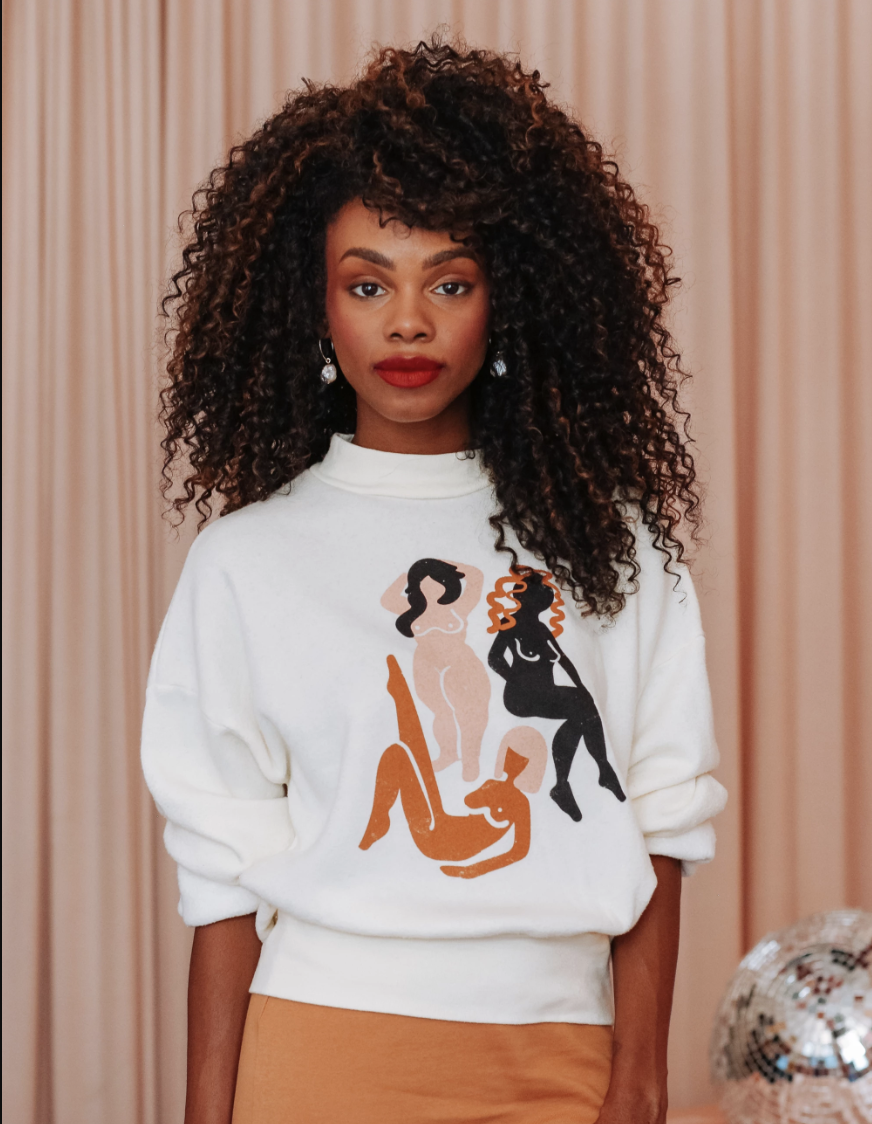
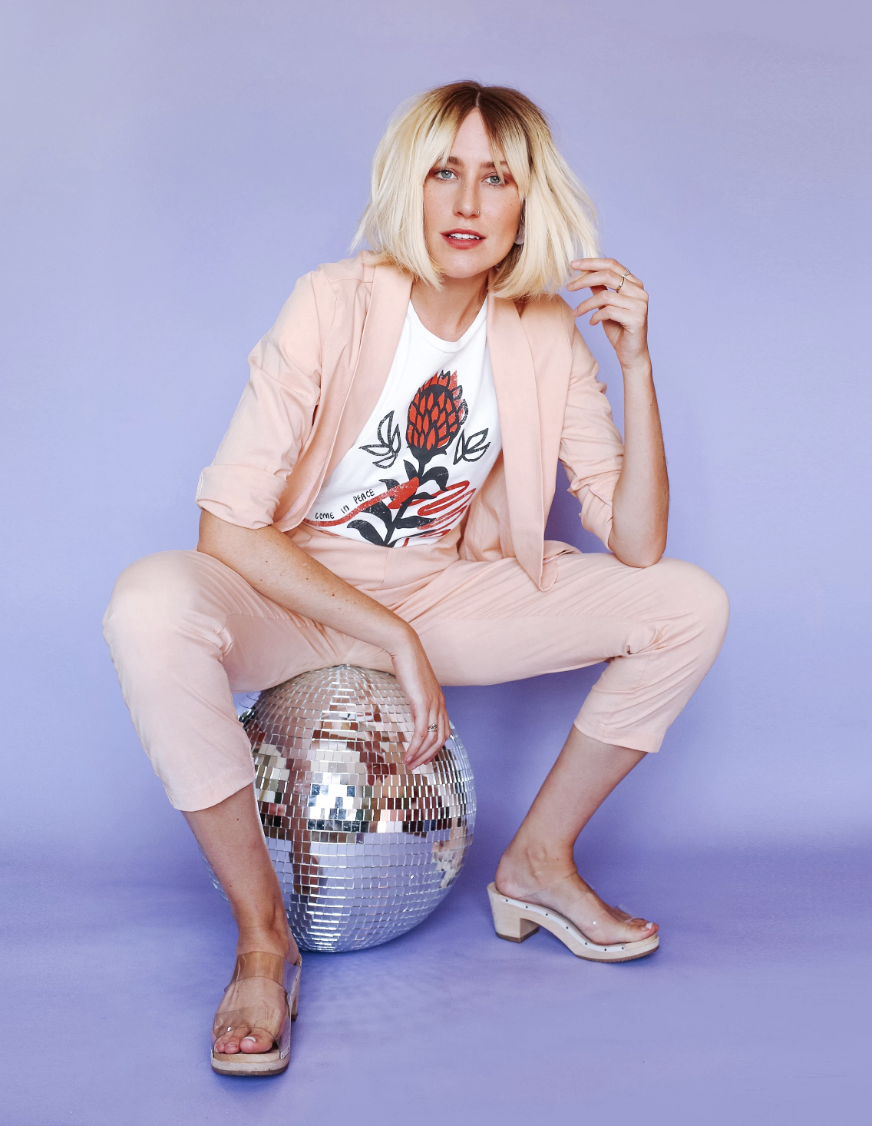
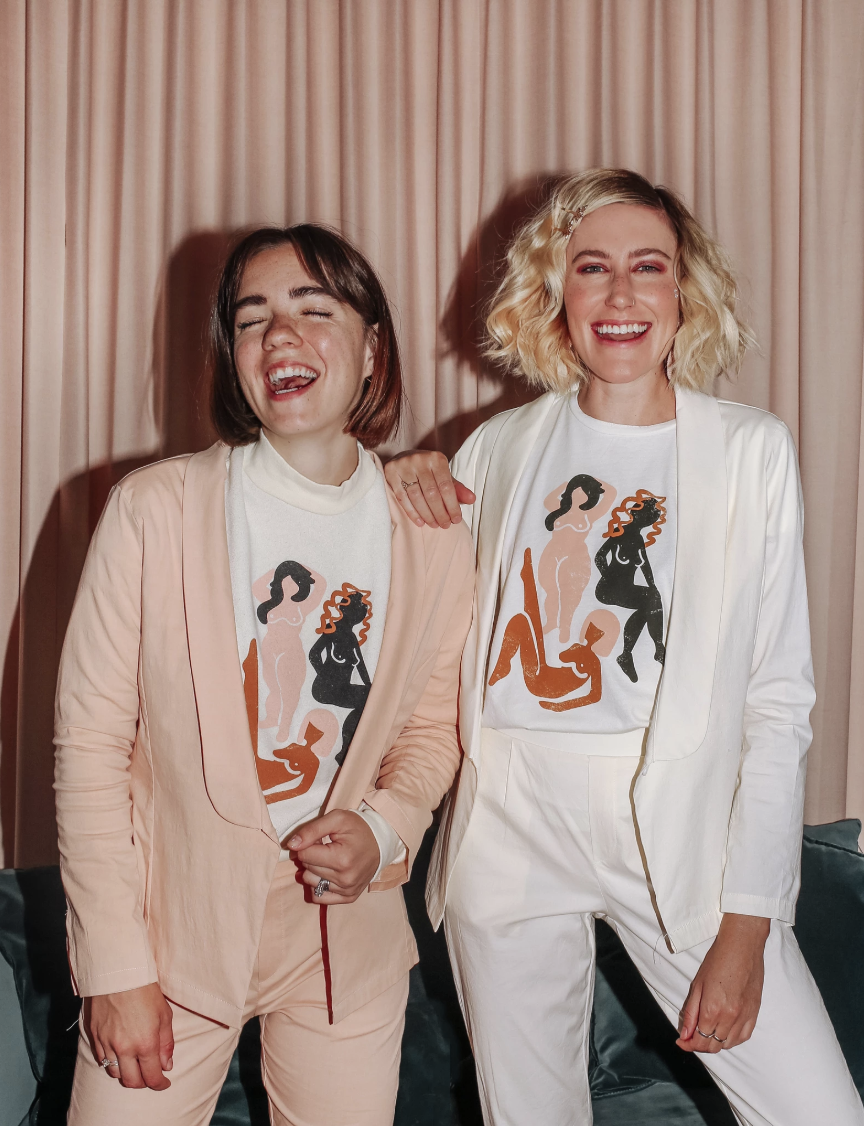
C&C: How did you find the manufacturer/production facility that you use? What advice do you have for other founders looking for a trustworthy manufacturer?
DN: “I didn’t find my current production partner until I was six months in. I was basically working with whatever I could find on Google, and it was really limiting my creativity. I went to MAGIC, the big fashion tradeshow in Vegas, hoping to get some freelance clients and bump some shoulders. I ended up being introduced to my production partner, Kelly, through one of my freelance clients. We immediately hit it off and realized we had so much in common.
“We both wanted to make beautiful and creative clothing while doing so as sustainably. We came up with and perfected our made-to-order, no waste model over the past three years. He has helped me go from ‘just a t-shirt brand’ into a full-on clothing line with things like suits, dresses, and even patterned fanny packs. I would say putting yourself out there is key. Go to sourcing shows, networking events, introduce yourself to people, ask questions, send cold emails, let the world know what you’re looking for and go find it.”
“Go to sourcing shows, networking events, introduce yourself to people, ask questions, send cold emails, let the world know what you’re looking for and go find it.”
C&C: Did you self-fund the company?
DN: “Dazey is fully self-funded. I was very careful to save a ton before starting Dazey so I wouldn’t be stressed or chicken out. I had saved enough to launch the brand that I could comfortably live off for a year. It has given me the flexibility to harness my creativity and grow at a pace that felt comfortable to me as a brand new founder and businesswoman. I know all the money I make is mine and I get to make the final call on everything. I think it was the right call for me starting out and we’ve been able to grow a lot from my initial $4,000 personal investment. I don’t know what the future holds, but I may be open to the idea of investment to really help scale in the near future.”
C&C: How did you know how to pay yourself?
DN: “Well, I made the mistake of starting off my business as a sole proprietorship. Which means everything from the business was through my personal bank account. Every expense and every payout. Now I’ve learned that’s not a good practice if you’re really trying to grow a company outside of just freelance work! You really need to keep them separate. Since then, I’ve of course established a C-corp and company account.”
“My personal pay always varies depending on how the company is doing. When things are good, I allow myself to experience the benefits. When they are slow, I pull back. Last year we had an amazing year and I paid myself more than I had ever dreamed of making with my corporate jobs. This year, we’ve had a slower summer. I’ve decided to keep all of the money in the business account and live off of my savings and rental property income for awhile. A lot of founders don’t let themselves enjoy the successes and I think that can be a quick route to burnout. I like going with the flow and staying in-tune with my company.”
C&C: How big is your team now? What has the hiring process been like?
DN: “We have five people in our immediate team now. I had never hired anyone before and remember being so excited to give the first interview. We’ve gotten so lucky with our team and everyone I’ve hired since year one is still here today. Myself as the owner and CEO, Phillip our COO (who is also my amazing boyfriend), Megan who manages our Dazey Lady Shop, Naomi who helps me with content and creative, and our newest Lisa who is doing customer service and shipments. When it came to interviewing, I trusted my gut feeling. I didn’t get too hung up on resumes because I know people can easily learn on the job, just like I had.
“It was more about the conversation and connection I had with them. Things like if I could trust them, get along with them, that they cared about the company, and I think they are a hard worker. So far, it hasn’t steered me wrong. Of course, we have so many other people that are basically apart of the Dazey family, like our production team and sales showroom reps. It really takes a village, even as a super small company.”
“I had saved enough to launch the brand that I could comfortably live off for a year. It has given me the flexibility to harness my creativity and grow at a pace that felt comfortable to me as a brand new founder and businesswoman.”
C&C: Did you hire an accountant? Who helped you with the financial decisions and set up?
DN: “Yes, and I wish I would have sooner. She had to go back pretty far to correct all the unbeknownst co-mingling I did (using both my personal and business account instead of keeping them totally separate). That was totally a waste of time when I could have been working with her all along and without stress. Especially as a business begins to grow, the finances can quickly become hard to track. It’s best to start off with the right person in place so they can grow with you and make sure your books are done right. Accounting is not my forte, so why not focus on what I’m good at—making the money—and then let the professionals handle it.”

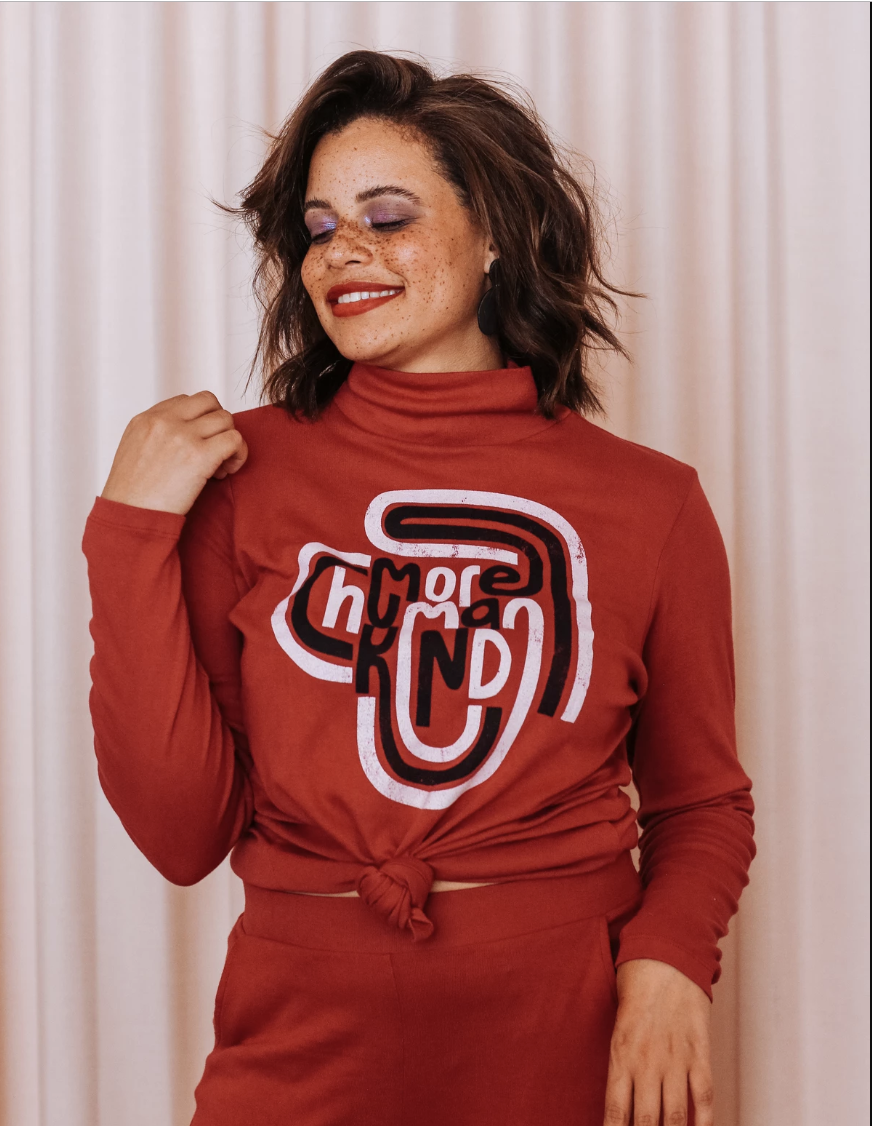

C&C: What has been the biggest learning curve during the process of establishing a business?
DN: “As somebody who has always considered themselves good with money, I’ve discovered it’s been a whole different beast as a business. You really have to stay on top of where effort and money are being spent and if the direct return merits that amount. When you start to deal with so many big numbers going in and out quickly, things can get confusing.
“Be sure to stay on track of your finances and know what number you really have in the bank (with expected income and expenses). Make decisions carefully and constantly re-evaluate spending/saving. You really do have to spend money to make money, but make sure you are smart and strategic about it.”
C&C: How did you get retailers to start stocking your product?
DN: “When I first launched Dazey, my focus was on direct to consumer selling and marketing on Instagram. I didn’t think wholesale was important at the time. I wanted to keep my production ethical but also keep my prices reasonable, which made my wholesale margins pretty dismal. I would take wholesale orders here and there if people reached out, but it wasn’t my focus. Fast forward about four years later and it has shifted to be a pretty big chunk of our business. Instagram was everything we needed to start building an engaged and supportive community. Direct website sales were growing like crazy and we thought we had it made in the shade. Then came the dreaded algorithm.
“Additionally, I will say there has been a shift in consumer behavior as more people begin to experience social-media fatigue and distrust. All that dramatically affected our online sales. We pumped up our online ad spend, but it didn’t really help either. I talked to some other entrepreneurs and they all reported the same. Semi-freaking out, I sat down with my production partner to plan our next move. He suggested we give wholesale a proper try. As an industry veteran who had spent most of his career in B2B (business to business as opposed to direct), he thought it could really help us. We had to restructure our pricing to make our margins more fair for us, and then we found a wholesale showroom.
“I walked into the Cooper fashion building in DTLA and grabbed a directory and started sending out cold emails based on the brands the showrooms already carried. We got four meetings, sat down with all of them, and found the right fit—a smaller showroom with a focus on made in USA products. It’s been a game-changer. Dazey now does amazing with wholesale and sells out of boutiques faster than they can reorder. The fact that we built a large social media following and people knew our name has made it easier than starting out with wholesale. We are now even carried by Free People who happened to just find us on Instagram.”
“Be sure to stay on track of your finances and know what number you really have in the bank (with expected income and expenses). Make decisions carefully and constantly re-evaluate spending/saving. ”
C&C: Do you have a business coach or mentor? Would you recommend one?
DN: “Kelly my production partner has been a huge mentor for me. He saw potential when Dazey was nothing and took a bet on me with blind faith. I would also say my community of fellow female entrepreneurs has been one of the biggest driving forces in both mentorship and inspiration. Peer to peer mentoring is amazing because we are all learning and growing together. Outside of Dazey, I co-founded a boutique female co-working space called Biz Babez has been a great connector and space to learn from one another.”
C&C: How did you promote your company? Did you know anything about marketing before this venture?
DN: “I had started fashion blogging in college before Instagram had even existed. I was connected with a bunch of girls via a website called lookbook.nu and when I moved to L.A., we would help each other snap photos of outfits to share on our blogs. I quit blogging when my full-time job got to be too much (this was before you could make money off of it). But many of the girls I knew kept at it and ended up becoming huge successes in the fashion blogging space.
“When I started Dazey, a lot of them were so helpful in shooting content with me and promoting. I would take all the photos myself and also snap pics of whatever they wanted in exchange. This was a great way to get the word out at the very beginning. Then once I built a following myself, I just chose to be very personal and real with my community like sharing the BTS of running a small biz. I would share my design process, my production, and really all the highs and lows of running a business. That’s when things really started to take off from word of mouth.”
“As a hyper-creative person who’s not necessarily the best at all that, I’ve also learned to lean on other people. Know what you are good at and focus on that.”
C&C: What is one thing you didn’t do in the setup process, that ended up being crucial to the business and would advise others to do asap?
DN: “Get everything in order—your bank accounts, contracts, your LLC or CORP. Read a business book and get to know the less glamorous side of small biz. As a hyper-creative person who’s not necessarily the best at all that, I’ve also learned to lean on other people. Know what you are good at and focus on that. Then hire help for the rest. Your efforts will be best spent doing what you love and what you’re good at.”
C&C: For those who haven’t started a business (or are about to) what advice do you have?
DN: “Do the damn dream. That’s printed on a Dazey tee. But honestly, the only regret I have with starting Dazey is not doing it sooner. It’s a rollercoaster but so worth it. Your dream job simply doesn’t exist—you have to create it.
“So many times I thought I knew what my ‘dream job’ was until I actually got it and realized that wasn’t the case at all. With Dazey, I’ve been able to combine all of my passions into one thing. From fashion, art, design, photography to social media, feminism, and sustainability (and even somehow interior design now). I designed Dazey to be true to everything I love and believe in. And my customers can see and feel that. If you build a business that you are undeniably passionate about, it’s damn near impossible for it to fail at it.”
School of Side Hustle Lesson 4: From Market to Marketing!
All the tools you’ll need to market your business.
For those of you just joining our Create & Cultivate x Weebly School of Side Hustle Series, where have you been? Missing out, that’s where.
Luckily, we love a recap.
In “Lesson One: Building a Brand Online,” we talked to Emily McDowell, founder of The Emily McDowell Studio about the basics of brand building.
In “Lesson Two: From Concept to Commerce,” we talked to illustrator and artist, Carly Kuhn (@theCartorialist) about her advice for selling online and what kind of websites she prefers.
In “Lesson Three: Don’t Just Build a Website, Build a Business,” Kelsey Kelley of KKelley Designs walks us through her hustle and flow.
Caught up? Good. Because it’s full steam ahead for “Lesson 4: From Market, To Marketing.”
Watch: Lesson Four From Market to Marketing
At stage right, we’ve got @DazeyLA.
Dazey LA is a brand that stands out.
And yet it’s founder, Danielle Nagel, says she started off the same way so many businesses begin: with a side hustle. (Are you sensing a pattern here?!)
“I started off with odd jobs for friends, print shops, doctors offices, and slowly worked my way up,” Danielle shares. “Fast forward 6 years later and I was full-time designing apparel graphics for large companies like Urban Outfitters, Anthropologie, Forever 21, Macy's and Nordstrom to name a few! I had a great career as a young designer but all I really wanted was to start my own brand and design shirts that stood for something.”
The idea of standing for something and taking a stand against fast fashion was vital to Danielle’s success. From the start her brand has been about transparency-- this wasn’t only a marketing ploy.
But like so many others, even Danielle had the concept, she had to take “the leap” we talked about in Lesson 2. “I still always say my biggest challenge was actually gathering the courage to start Dazey. It took me years to finally do it. Self-doubt and other peoples negative opinions can so easily slip in. Of course, it wasn’t easy sailing after that, every season of my company presents new challenges. You just have to learn to take them one at a time. Believe in yourself.”
Photos by @Dazey_LA
Danielle adds that she had to work to be taken seriously. “It can be hard to be taken seriously, especially when I come skipping into a factory wearing pink shoes and spice girl buns. I may not look it but I can be a tough bitch when push comes to shove and I will stand my ground and protect my company. Ask for a better price and better product every single time! Find production people you trust and who respect you. It will save you some serious headaches. Never forget you are already endlessly brave for starting a company in the first place, use that power!”
This is something we talk about at C&C all the time: Your power tools. Standing your ground. Protecting your company. Walking into a warehouse and asking for exactly what you want.
But you also want tools on the backend to do the same. You want tools that work for you-- not against you. Tools that make your site searchable. Tools that make sure you are getting all of eyeballs on your product.
Katie Swett, Director of Product at Weebly knows all about this. When it comes to marketing 101, Katie says,
“Learn to use your tools! The big brands have huge marketing teams and budgets to power intelligent marketing. BUT a lot of that power is now available to small businesses."
Platforms like Weebly Promote can help you automate campaigns, personalize content, and market uniquely to different segments.
Katie also encourages those new to marketing to be sure to collect email addresses. “Don’t wait to get started with marketing! Even if you are not ready to sell your product, it’s always a great idea to create a Coming Soon Page that collects the email addresses of people interested in learning more about your business. This list of subscribers can start small with friends and family, but will be meaningful over time,” she says.
As Danielle has, Katie encourages new brands to get to know their customers. “Respond to them when they reach out on social media, ask them questions, listen to their complaints and use that information to build a community that reflects your brand.” More so, she says you need to, “Be your authentic self! You have a huge advantage when you’re starting, you can be real and authentic with your customers. That’s harder for bigger brands to do. Tell you story, be transparent, make them feel like they’re talking to a human. That’s the little guys secret weapon.”
It was certainly part of Danielle’s secret weapon.
So let’s fill up your arsenal a bit more.
We’ve touched a bit on marketing, but we want to dig a little deeper. In Lesson 4: From Market to Marketing, Jaclyn Johnson talks with Katie who is going to walk you through marketing tools and techniques, which include Weebly's latest product, Weebly Promote, an integrated marketing platform.
As discussed in Lesson 4's video, an essential part of marketing, is the kind of grassroots engagement you do with your followers. Because, once you’ve built your brand, your site, and your following, you need to keep said followers engaged. It’s an important part of the game. So we asked Katie Swett for some other pro-tips on how tools like "Weebly Marketing" and help you build and maintain your customer base." These automated tools allow you to work smarter, not harder.
With Weebly you can:
Build brand awareness and drive traffic to your site by creating Facebook ads right from the Weebly platform.
Use the benefits of Automation. Abandon Cart Emails allow you to automatically detect when a customer leaves a cart with products in it and sends them an email follow-up with their abandoned products. This lets you potentially win back customers you may have lost without doing any work.
Try different prices, sales, offers and messaging and see what works best for your audience. Weebly has an Insights dashboard that gives you analytics on your computer or phone so you know what's working (and what's not) right away.
Break your audience up into targeted groups. Then you can send different emails to people that visit you every week, than you do to people who have only visited one. Or, different emails to people who normally buy mens clothes, than you do to people how normally buy womens. This personalization helps you send more resonant emails to smaller groups, without overwhelming people with too many.
Build up a list of subscribers. Email marketing is still the most effective marketing tool to maximize your ROI (return on investment). It’s is how you start a relationship with your audience, and how you will ultimately turn visitors into customers.”
For Danielle, part of her marketing plan means connecting with her customers on a “deeply personal level” as well as “sharing what the day-to-day life of an entrepreneur really looks like.”
It’s all about connection.
Katie likewise encourages small businesses to connect with their customers on an intimate level. She says, “Social media has made it easier than ever to start communicating with potential customers. We always recommend heading out to farmers markets or craft fairs to have those face to face conversations with your customers. You will be amazed how grateful they are to speak with you and learn more about your story. In turn, you will get real feedback from customers that can dramatically shape how your grow and iterate.”
That doesn’t mean it’s the right direction for everyone, but for Danielle and Dazey LA, it gives her work meaning. “I noticed so many of the boss babes I looked up to didn’t share the nitty gritty or their biggest tips and tricks,” Danielle says. “Those were the things I was dying to see when I was still in my corporate design job daydreaming of starting a company. Being open has hands down been my biggest asset. So many small businesses feel the need to look more professional or bigger than they actually are. I choose to do to the opposite and embrace being a small one-gal company. People are so much more excited to support something small, real, and relatable. My suggestion to people is to be as true to yourself and your mission as possible. Align your beliefs with your company and then promote the hell out of it!”
Ahh. Promote the hell out of it. That’s part of your job as a small business. And you need to get comfortable with self-promotion, even if there are other parts of launching that scare you.
Danielle assures all her side-hustle people who are unsure of the next step that you don’t have to know “business” to create a successful business. “You don’t have to know anything!! You just need to find the people who do." I knew how to design shirts and that was basically it. You learn so much as you go and there is no rules to follow. Put yourself out there and you will figure it out. It’s the wild west baby! - Also Google is your best friend.” Shop Danielle's latest collection here.
And so is Weebly, we would add.
Have more questions, drop us a line below and we’ll get them answered!
Be sure to look back at Lesson One: Building a Brand Online, Lesson 2: From Concept to Commerce, and Lesson 3: Don’t Just Build a Website, Build a Business.
MORE FROM THE BLOG
School of Side Hustle Lesson 2: From Concept to Commerce
A creative’s guide to easy e-commerce.
In Lesson One: Create & Cultivate + Weebly talked brand building basics. We worked through some simple, but necessary brand building exercises. And we read up on how Emily McDowell grew her online card side-hustle into a legit brand. So let’s turn the lens on you for a minute.
You’ve done the brand work. You’ve figured out your three adjectives. You’ve played “This Not That,” and you’re ready. But, you’re not. But.... you are. You think. *Scratches head.*
Are you ready? It’s a hard question to answer because the “launch my biz” trepidation tremors are real. Of the hundreds of women we talk to about entrepreneurship the common thread is “the leap.” At one point they’ve all faced the challenge of closing their eyes and sprinting straight ahead. You need guts, because as you know, without guts there is no glory.
Watch: Lesson 2 From Concept To Commerce
Carly Kuhn, AKA The Cartorialist, had to take one such leap. And it all started with a secret Instagram persona. When she launched @theCartorialist she was working full time on “Chelsea Lately.” She had no clue what her illustration side hustle would turn into, nor did she want it to look like she was trying to switch careers. However, Carly did know that she had to show the world the artist within. “Working in comedy,” Carly says, “I thought it may be awkward to tell my coworkers “Hey guys, I started an Instagram account where I draw people, check it out!’”
But she gathered her courage and did it.
“I think the reason I had the courage to actually go through with it was because I had been doing Improv and Sketch comedy for a few years. Let me tell you - standing on a stage with no lines, improvising comedy to a group of strangers seemed much more daunting to me than posting a drawing to the unknown abyss that is the internet! So, I guess you can say, without comedy, I wouldn’t have had the chutzpah to show my art to the world!”
It was that chutzpah that turned into her first sale. “A lot of the monetization happened organically,” she says. “For example, my first paid job (while I was still at “Chelsea”), a PR company hired me to draw a few top magazine editors that they then framed and gifted to them for the holidays. I had no clue how to price this- I think I just made up a number! They came back with their budget, and what worked for them. That’s kind of how it happened in the beginning. And once I had one paid job under my belt, that was my barometer for pricing moving forward.”
With that sale she knew she could take her idea from concept to commerce. If one person is willing to pay, so are others.
But all of those questions about pricing and getting started are tricky. Which is why in Lesson 2: From Concept to Commerce, Create & Cultivate's CEO & Founder Jaclyn Johnson is breaking down a creative’s guide to easy e-commerce.
Now, that’s a lot of info to take in. But here are some of the basics, further explained.
One of the most important touch-points for you brand is your website. And Weebly gives you the ability to create one that tells your unique story. Weebly offers users the ability to tell their unique story. And storytelling is the rock solid foundation of any successful brand. With Weebly you can:
Choose a unique online store design with a customizable theme to showcase your products. Their easy-to-use drag & drop builder helps you launch your online store quickly.
They also offer intuitive and time-saving marketing tools, which are incredibly useful when it’s only you, business party of one. With Weebly you can:
Use customizable email templates, like an abandoned cart or welcome email, to connect with your customers.
Optimize your site for SEO to help search engines discover you. Their analytics tools help you track site performance. Plus, you can further enhance your store with partners from their app center.
Their blog also offers a ton of amazing and useful content for new builders. From the “4 Questions to Ask Yourself When Designing Your Web Store,” to turning a one time customer into a return customer, to how to design your site so that it’s optimized for SEO. When you’re launching there is so much to consider-- the good news is, Weebly has already considered it for you. Seriously. Do you know what your “hero” product should be? Or what people should see first? These are all small details that require patience, thoughtfulness, and attention.
Even as your business grows, there are a million considerations. For Carly, selling is still a work in progress, but she encourages young entrepreneurs to do their research. “I had a hard time pricing out my work in the beginning (and still do!). But today, there are a lot of resources out there. You can approximate the pricing of your work through research. There are a lot of other art/design websites out there that can give you a sense of what is being sold and for how much. Then go with your gut...what feels right.”
She also shares this insider piece of advice: “I feel like I am only now just beginning to get the hang of it! But, what I did learn very quickly is that the holiday season is when most customers want to make their special art purchases. So, if you can launch a site/start selling your work, do it in time for the November/December holiday season!”
As for how she prefers her sites to look and feel? “A website should be clean, clear, not overwhelming to the eye, and user friendly. I typically like a white background with black text, but that’s just me! Let the content speak for itself. If you can’t navigate a website easily, people will leave it after a few seconds.”
Let the content speak for itself.
Whether you opt for a white background with black type, or you’re into a more colorful interface, Weebly has options. But we bet they’ll also tell you, make that website user-friendly, or that user will no friend of yours.
Have more questions, drop us a line below and we’ll get them answered!
Be sure to look back at Lesson One: Building a Brand Online and check in for Lesson 3: Don’t Just Build a Website, Build a Business and Lesson 4: From Market To Marketing.
MORE FROM THE BLOG
4 Steps to Do Away With That Pesky Five-Year Plan
Let's focus on the next five minutes, shall we?
Photo credit: Vibe Tribe
As the bartender made his way over with four birthday shots in hand my girlfriend looked at me and said, “Chels, I don’t want to turn 26.”
At first I thought it was a bad attempt at making a joke but the look in her eyes told me she was actually being serious. I gave her the biggest hug as I tried to wash away the confused feeling in my chest. Despite having a passionate budding career under her belt, a loving man by her side and the greatest friends behind her, she still felt that she wasn’t exactly where she “needed” to be. As we raised our glasses in honor of the birthday girl I found myself distracted by the elephant in the room that apparently now comes with turning a year older. Instead of celebrating it with arms wide open, society has cast a spell over us saying if we don’t have x, y, and z by the time we blow out a certain amount of candles then we must be doing something wrong. We than proceed to beat ourselves up and never take a moment to stop and realize that possibly, we are doing everything right.
Let me ask you this, have you ever thought that you could actually plan out your entire life?
Half of you are currently laughing at me while the other half know exactly what I’m talking about. If you fall into the latter category, you aren’t alone. I am completely guilty of being the college senior who sat at her desk and wrote out a 5-year plan. I put my heart and soul into that color coded timeline so it may come as a surprise when I say that I am forever thankful that the plan on that piece of paper never became my reality. The person I loved, the city I wanted to call home and the job I strived to land were all meant for the girl who I was then, not the woman I am now.
Here are a few steps you can take to say goodbye to the 5 Year Plan:
1. DON'T DRAFT A TIMELINE BASED ON SOMEONE ELSE'S
As cliché as it may sound, playing the comparison game will only lead you to a dead end. Comparisons can either make you feel superior or inferior and neither of those feelings serve a useful purpose. Write your own story, learn from your own experiences and live your life through your eyes.
"Playing the comparison game will only lead you to a dead end."
Tweet this.
2. EVALUATE YOUR GOALS
Saying goodbye to the 5-year plan does not mean you should wash away your goals, no ma’am! Instead, use this as a chance to check-in with your personal and professional goals and know that it is absolutely OK to tweak them if you see fit to do so!
3. BE NICE TO YOURSELF
When you are your own best friend, you don’t seek out validation from others because you realize that the only approval you need is your own. This is your life, your journey and once you recognize the value to that then no one, not even a ‘plan’, can get in the way of your happiness.
"The only approval you need is your own."
Tweet this.
4. WELCOME NEW OPPORTUNITIES
Since life doesn’t always go according to plan being able to welcome new opportunities with open arms is key. How silly would it be to close the door on an opportunity just because it wasn’t color coded on a piece of paper you drafted up three years ago? Don’t sell yourself short out of fear of not sticking to your 5-year plan, learn to ride the wave of life with a smile on your face and motivation in your heart.
Life is going to take a different path for every single one of us so constantly comparing your journey to someone else’s will only hinder you from making the moves that are meant for your life. Just because your best friend is engaged, your roommate landed her dream job or your younger sister purchased a house with the white picket fence all before you did does not mean that you are screwing up. With each new day and each year that you are lucky enough to blow out an added candle know that this is your life to live and your journey is uniquely beautiful.
Keep dreaming, keep loving and as always, just keep swimming.
Living on my own terms,
Chels
Chelsea Briche runs the popular blog The Millennial Miss. A platform for young women surviving their twenties with grace and a lot of humility. The platform is Chelsea's "pledge to you, the ones who haven’t quite figured it all out yet. That we, together, will immerse ourselves in every single thing possible; explore, love a lot, love a little, and never touch the ground."
More from our blog:
Why Ban.do's CCO Says There's No Shame In The Hustle Struggle
Pursuing your passion isn't all glitz + glam.
Our girl Jen Gotch is back with her business advice series. This week, the CCO of ban.do + breakout star of Instagram stories is answering your burning questions on the infamous work-life balance. One of our favorite pieces of gold from JG? "There shouldn't be any shame in the struggle of doing what you LOVE!"
Check the videos below for more gems on pursuing your passions!
Q: HOW DO I PERSEVERE TOWARDS MY GOALS + BALANCE CAREER AMBITIONS WITH MENTAL HEALTH/STRESS?
Q: HOW DO YOU PREVENT YOURSELF FROM BURNING OUT?
Jen also designed a super soft, short sleeve t-shirt as a little tribute to her advice series and 15% of the proceeds will be donated to writegirl, an la-based creative writing and mentoring organization that promotes creativity, critical thinking and leadership skills to empower teen girls.
Top 5 Things to Remember When You’re Searching for a Job
Don't do the spray and pray.
photo credit: Sugar & Cloth
Looking for a new job is hard. It's as simple as that, and it’s easy to forget these top 5 things to remember when you're searching. You may be working long hours at a day job while searching for the career of your dreams, or you may have left a job only to spend countless hours searching for a new position. Whatever situation you may be in, you’re not alone.
Searching for a job can be a long and tedious process, and it's easy to feel dejected, however it is important to keep your spirits up and remember that everything always works itself out. It doesn't make it any easier at the time, but often when you look back upon a time you were struggling, you'll see how far you've progressed. To make it a little easier on you, I've rounded up the top 5 things to remember when you're searching for a job:
DON'T TAKE IT PERSONALLY, AND TRY TO LOOK AT THINGS FROM A DIFFERENT PERSPECTIVE
You may have applied to hundreds or thousands of jobs, and it's easy to get down on yourself, but it's always important to look at things from a different perspective. You have no idea who's on the other end, sifting through applications. Sometimes jobs are only posted for legal reasons, even when the company has a candidate in mind. Don't take it personally if you don't hear from an online job application. Chances are that it has nothing to do with you!
REMEMBER THAT YOU’RE LIKELY ONE OF HUNDREDS OR THOUSANDS OF APPLICANTS
Because we have such easy access to job postings through online job sites such as LinkedIn, it is very common to be one of hundreds or thousands of applicants. The problem is that even if you’re completely qualified and would be a great candidate for the position, you may get passed over due to the sheer volume of candidates applying. Often there are so many applicants that determining which candidates should move forward is like finding a needle in a haystack. Be patient, make your application great, and don’t make the mistake of thinking that you’re the only person to apply.
"Be patient, make your application great, and don’t make the mistake of thinking that you’re the only person to apply."
Tweet this.
DON’T APPLY TO EVERY JOB UNDER THE SUN
Recruiters call this tactic “spray and pray,” and it’s not a tactic that anyone in the hiring industry would recommend. Contrary to popular belief, applying to more jobs is not better. The quality of each application you submit is much more important than the quantity. It’s much better to apply to a few jobs that you really want, and focus on customizing your resume and cover letter to each position than to cast wide net and apply to a lot of jobs with the same resume and cover letter.
When you use the same general resume and cover letter to apply to a plethora of jobs, recruiters and hiring managers can tell. By using terms such as “your company” instead of actually writing out the company name, or not referencing specific aspects of the company and/or job description, it becomes transparent that you’re using that resume and cover letter to apply everywhere.
What’s wrong with that? It gives off the notion that you’re too lazy to customize your documents, and that you don’t care about the company which you’re applying for. Make sure you show the hiring manager and/or recruiter who you really are and pour your soul into each application. It may be a pain at the time, but your effort will show through and benefit you.
YOU HAVE TO WANT IT, AND SHOW OTHERS THAT YOU WANT IT
I often see people who are applying for jobs they aren’t super excited about, and it is always very apparent in their applications. When on a job search, you have to be determined and know what you want. If you want something bad enough and work hard enough to get there, it will show through in your resume, cover letter, interview, and overall actions. Companies want to hire people who know what they want and will work their butt off to get there. If you’re neck in neck with another candidate, a company will almost always choose the candidate who wants it more. If you’re passionate, you’ll work harder, and that’s what kind of employees companies want to hire. If you can show how much you want the position in your application, you’ll always have good results.
DON’T BE AFRAID TO USE YOUR CONNECTIONS
This is one of the biggest mistakes people make. A lot of people seem to be afraid of using their connections because they don’t want it to appear as though they got the position because of who they know. It’s not ideal to be handed a job just because you know someone with authority, but reaching out to people you know in a similar field or work in a company you want to work for is always a good idea.
There may be a job opportunity coming up that you would only hear about through an internal source. You’ll still need to submit a resume and go through the application process, but reaching out to a contact could present you with a new opportunity that you had no idea existed. Remember that if you won’t reach out and use your connections, there are plenty of people who will, and they will be the ones to hear about new opportunities before anyone else. Chances are that you will never regret reaching out to a connection to let them know you’re looking for a job.
It can be hard to keep your spirits up during a job search, but remember that countless people are facing the same struggles as you, and at some point or another, every single person has been there. Take advantage of free time if you have it, and become the best version of yourself. Take a class, do some volunteer work, and polish your application package. No one will look down upon you for taking time to improve yourself. Regardless of how you’re handling your job search, don’t forget about these top 5 things to remember when you're searching for a job.
A native San Franciscan, Michele Lando is a Certified Professional Resume Writer and founder of writestylesonline.com. She has a passion for helping others present the best version of themselves, both on paper and in person, and works to polish individuals' application package and personal style. Aiming to help create a perfect personal branding package, Write Styles presents tips to enhance your resume, style, and boost your confidence.
MORE FROM OUR BLOG

